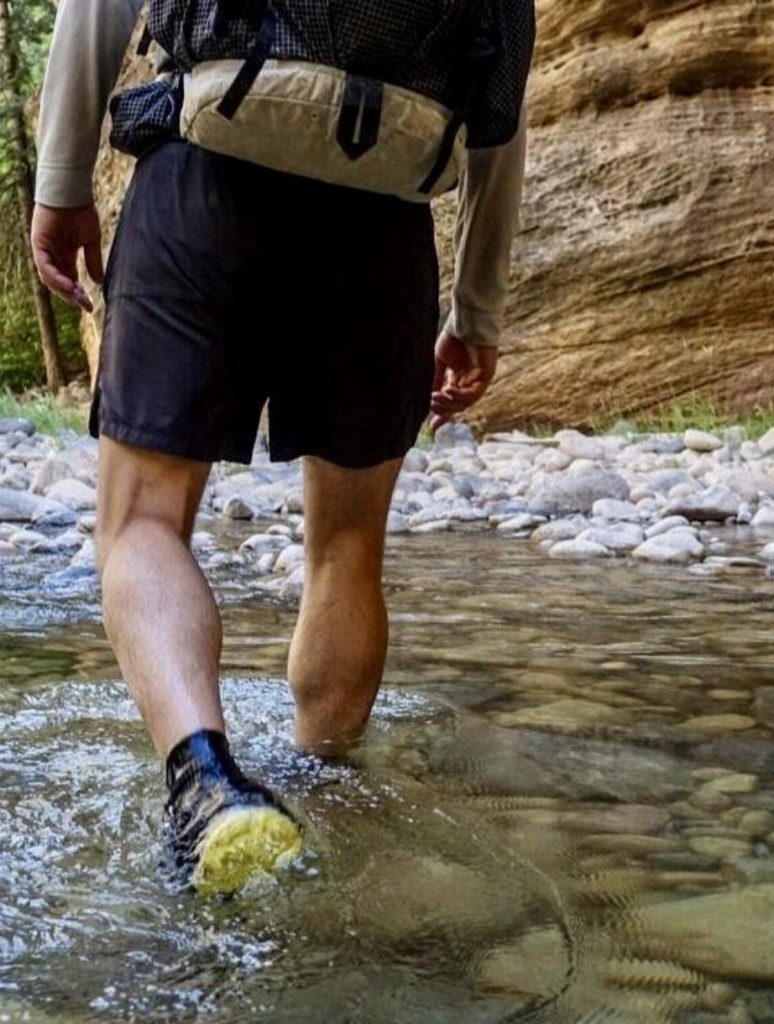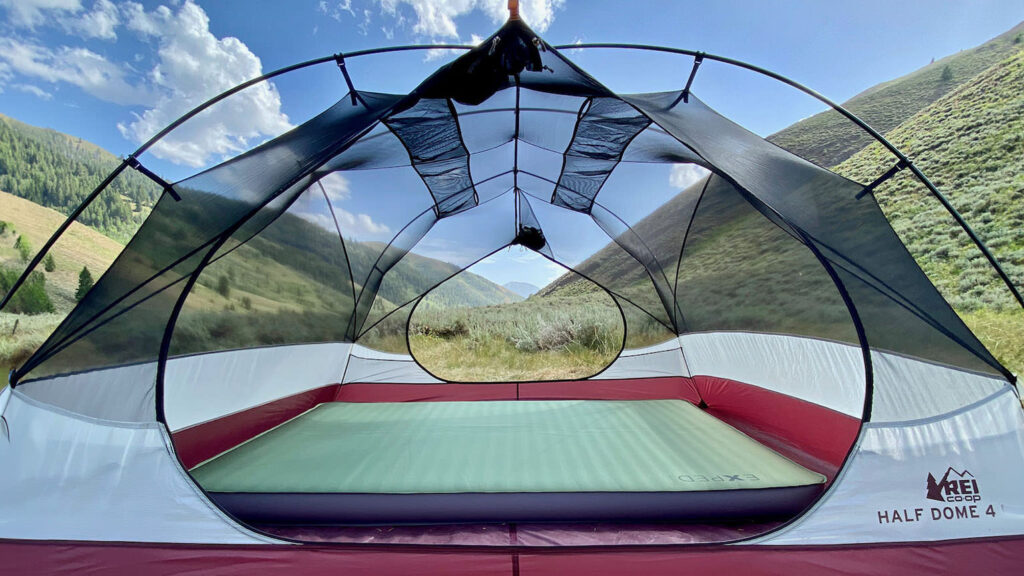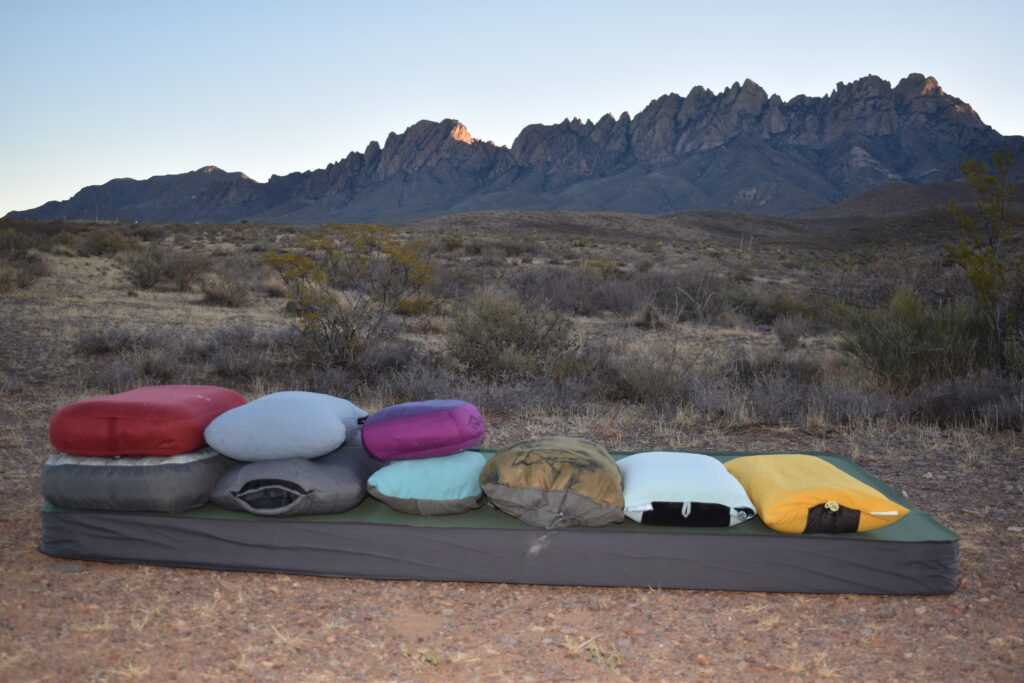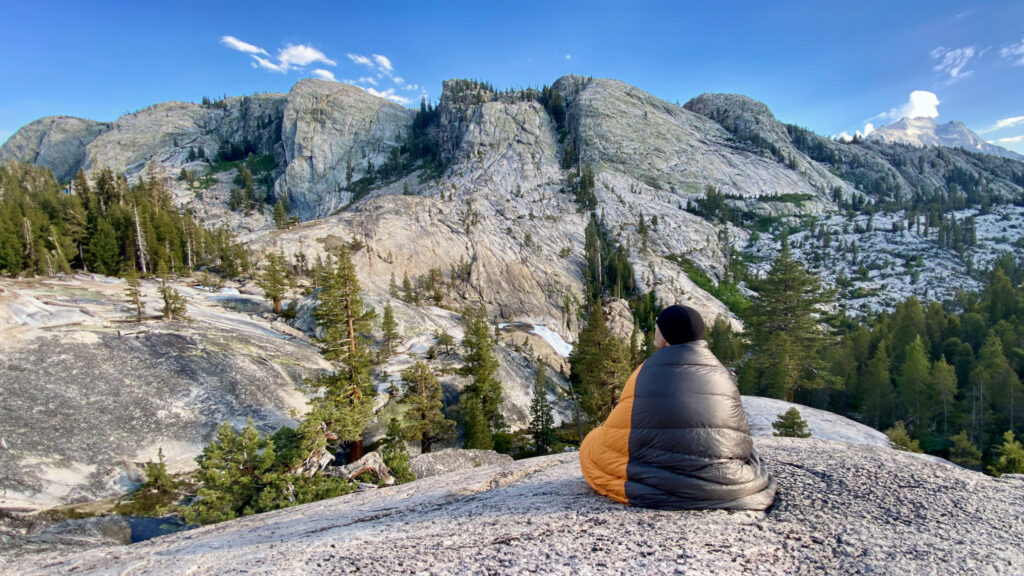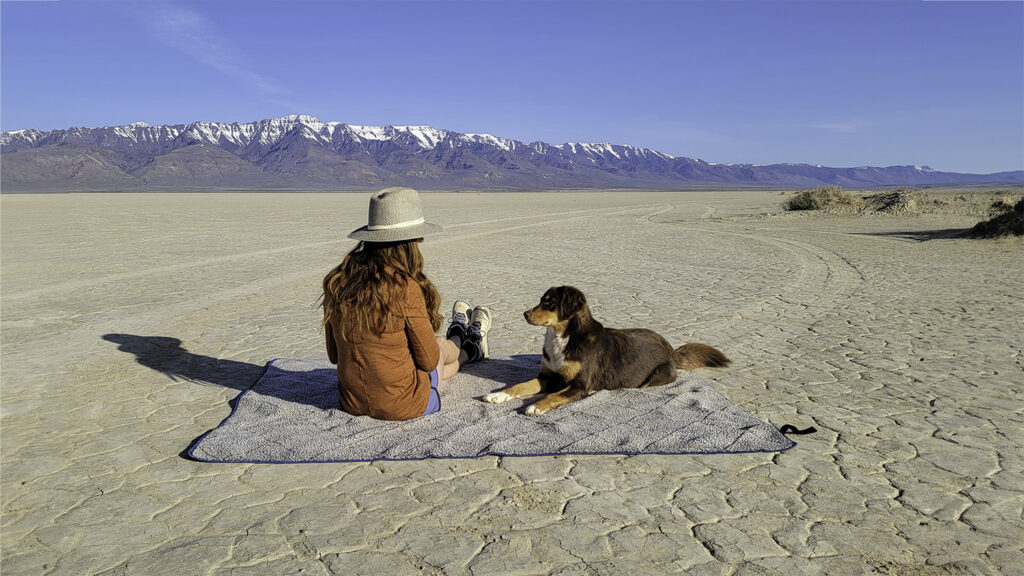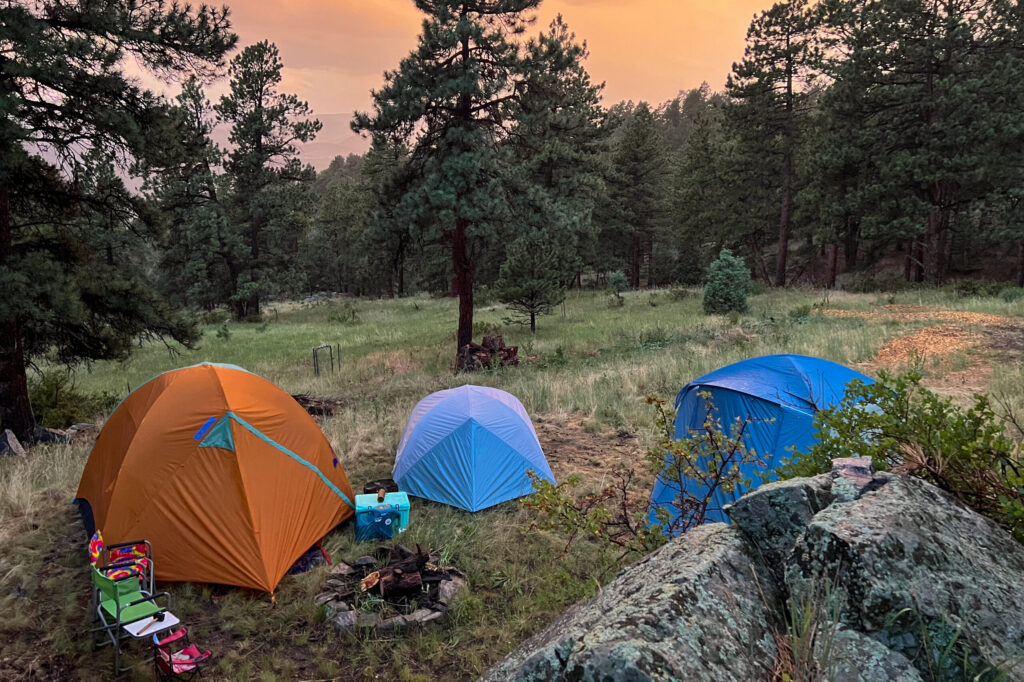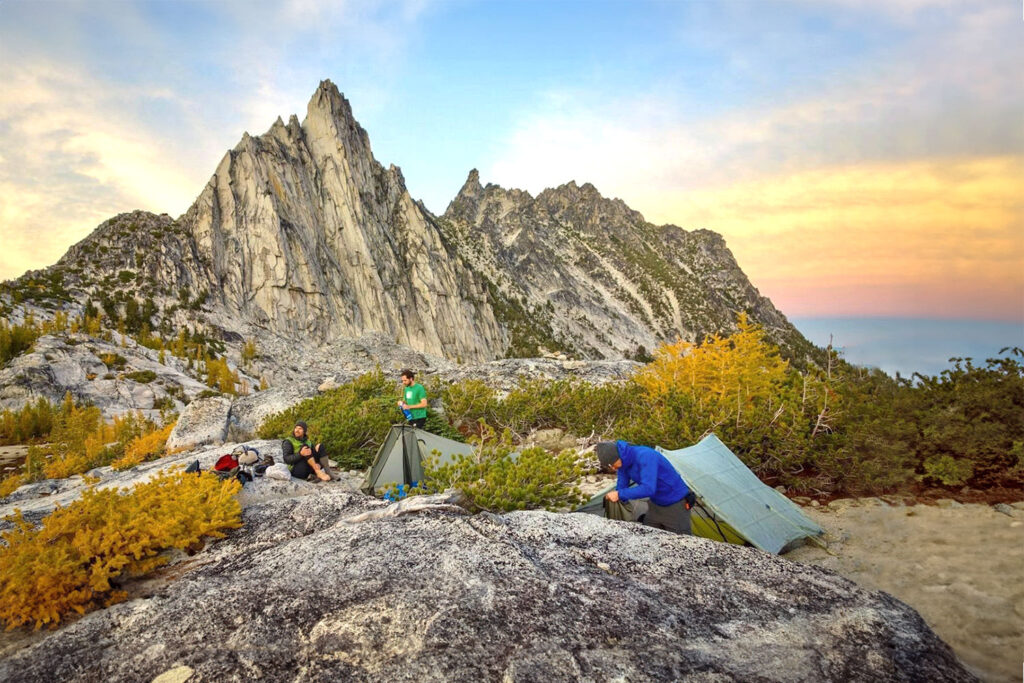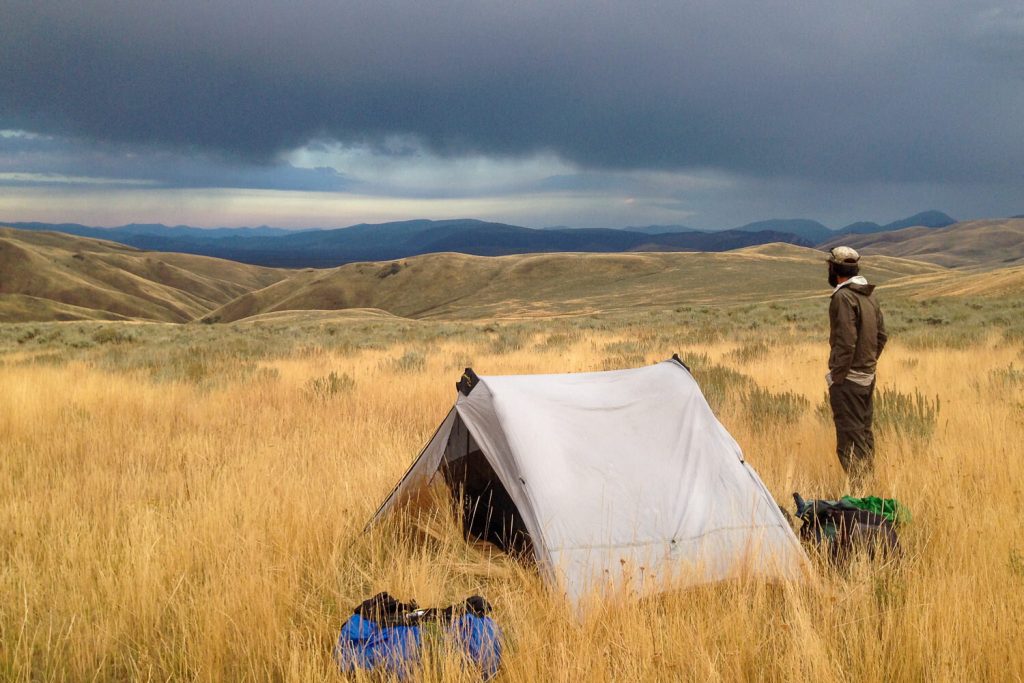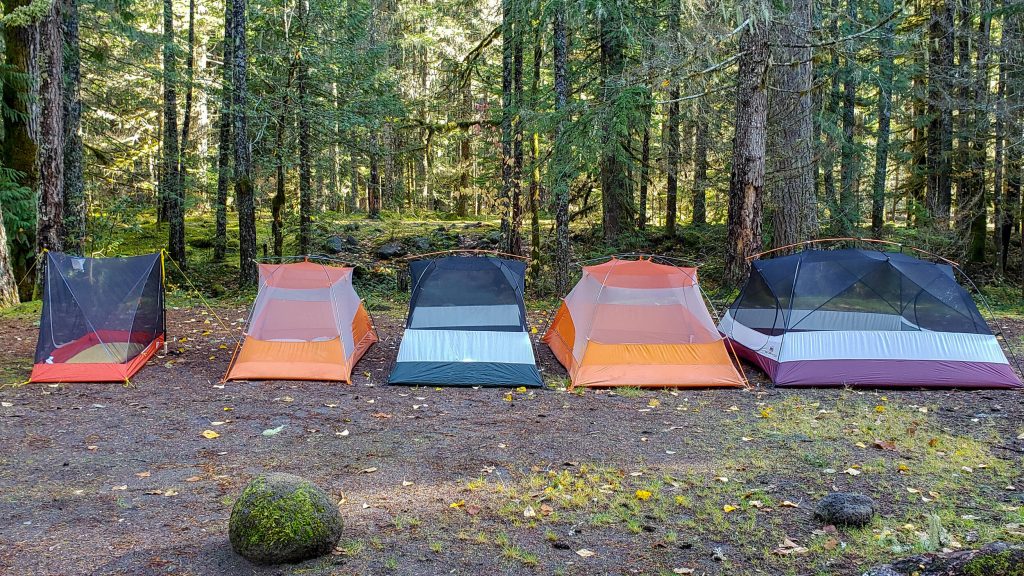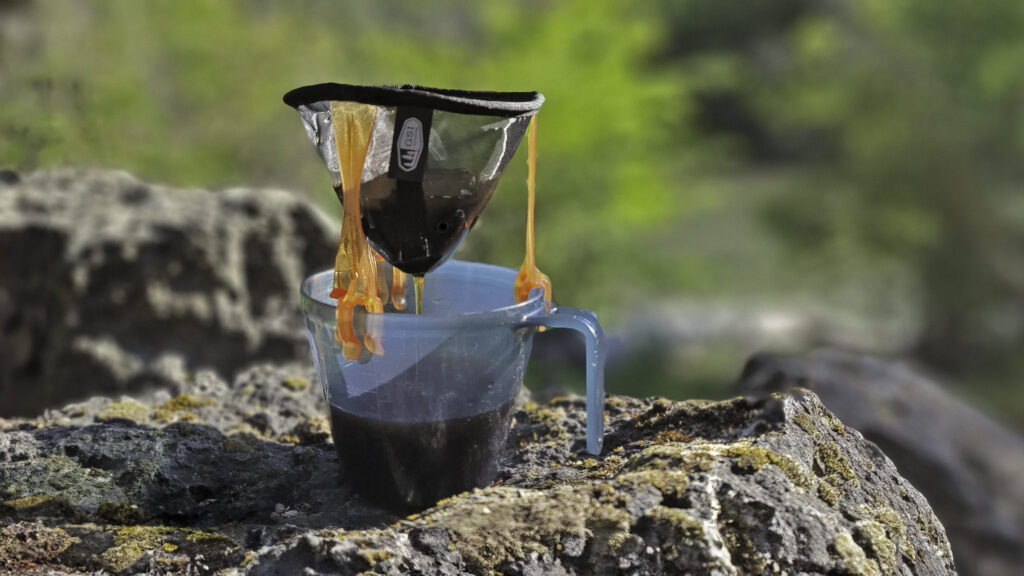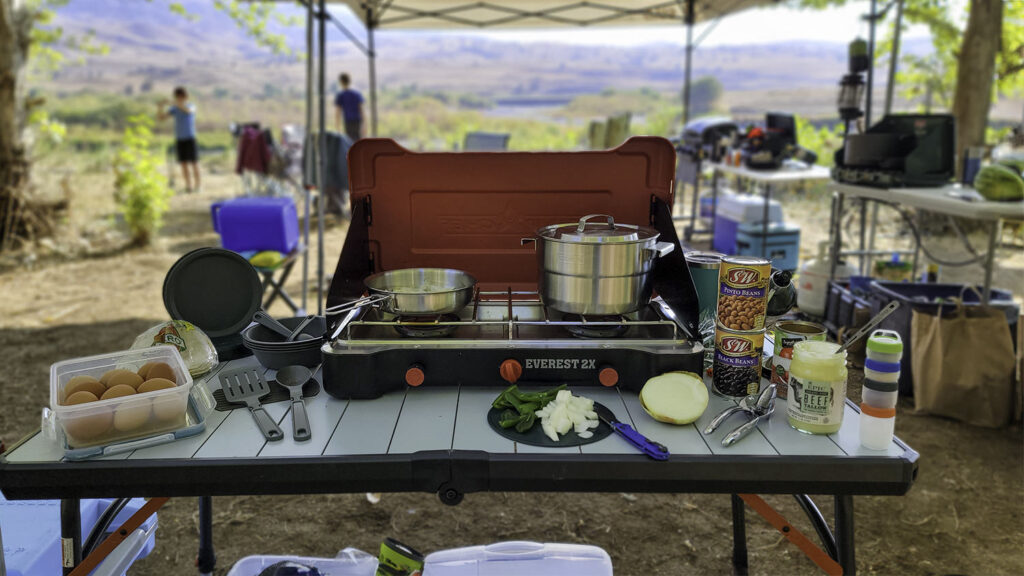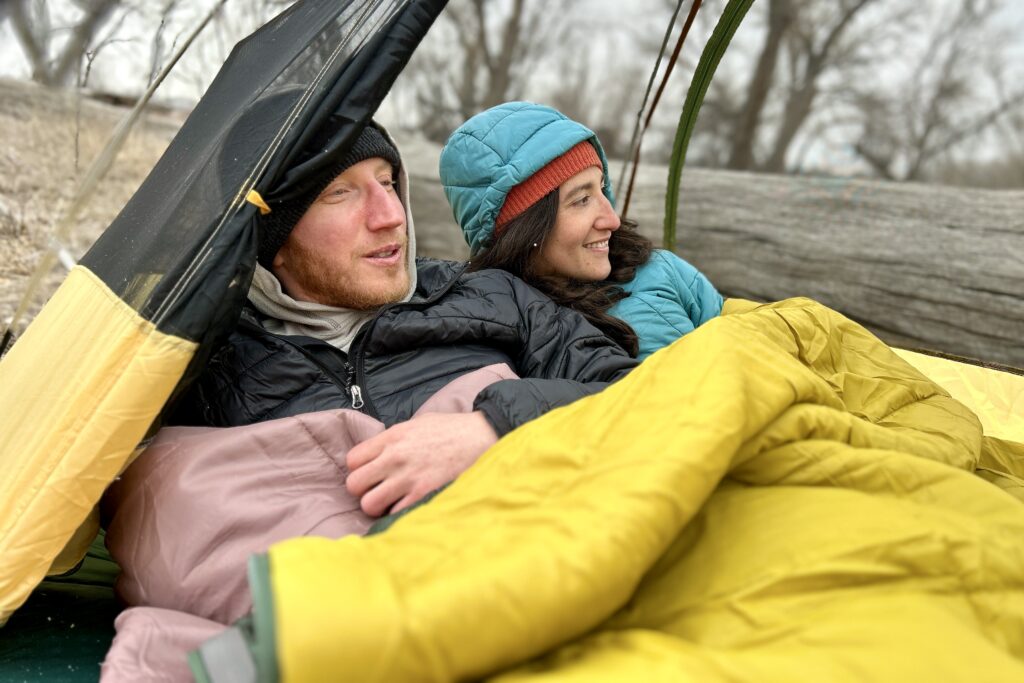
A quality sleeping bag will keep you warm and comfy so you can catch blissful Zs while you snooze at the campground. Our team of experts has spent thousands of nights in the woods and slept in over 40 bags to find the best options from brands like NEMO, REI, Kelty, The North Face, and more for your next frontcountry adventure. We test each bag for comfort, warmth, packed size, and other features to make sure we know them inside and out.
We’ll help you navigate the labyrinth of temperature ratings, down versus synthetic fill, double versus single bags, and other important considerations so you can find your new favorite for your next camping adventure.
And for more info, check out some of our other most popular gear guides:
Quick Picks for Sleeping Bags
Check out our favorite camping sleeping bags here, or scroll down for deep dives and in-depth reviews.
Best Camping Sleeping Bag Overall: REI Siesta Hooded 20 ($150)
Best Sleeping Bag for Features & Adjustability: Therm-A-Rest Boost 650 ($320)
Most Inclusive Camping Sleeping Bag for All Shapes & Sizes: REI Trailmade 20 ($100)
Most Comfortable No-Frills Sleeping Bag: The North Face Wawona 20 ($130)
Best Budget-Friendly Cold-Weather Sleeping Bag: Teton Sports The Celsius XXL 0F ($110)
Value Sleeping Bag with Excellent Warmth-to-Weight: Kelty Cosmic Down 20 Men’s ($170) / Women’s ($190)
Versatile Down Bag for Summer Camping & Backpacking: NEMO Disco Endless Promise 30 Men’s ($270) / Women’s ($270)
Best Sleeping Bag for Different Temperatures: The North Face One Bag ($350)
Best 2-Person Camping Sleeping Bag Overall: Kelty Tru.Comfort 20 Doublewide ($200)
Best Crossover Sleeping Bag: Mountain Hardwear Bishop Pass 15 ($285)
Luxury Sleeping Bag for Two with Excellent Features: NEMO Jazz 30 Double ($350)
Best Classic Heavyweight Sleeping Bag: ALPS OutdoorZ Redwood -10 ($160)
Best Budget Camping Sleeping Bag: Coleman Brazos ($47)
Lightweight Sleeping Bag with Temperature Options: Exped MegaSleep 25/40 ($150)
What’s new
Night after night, our team has been testing new sleeping bags and comparing them against our all-time faves. Check out these new additions:
- The REI Siesta Hooded 20 is our top pick for 2025 with a blend of awesome features, packability, and a cozy, bed-like feel at a budget-friendly price.
- The Therm-A-Rest Boost 650 makes the cut – and earns an Editor’s Pick – as a warm and versatile bag packed with unique features for camping and backpacking.
Camping Sleeping Bags Overall Testing Scores
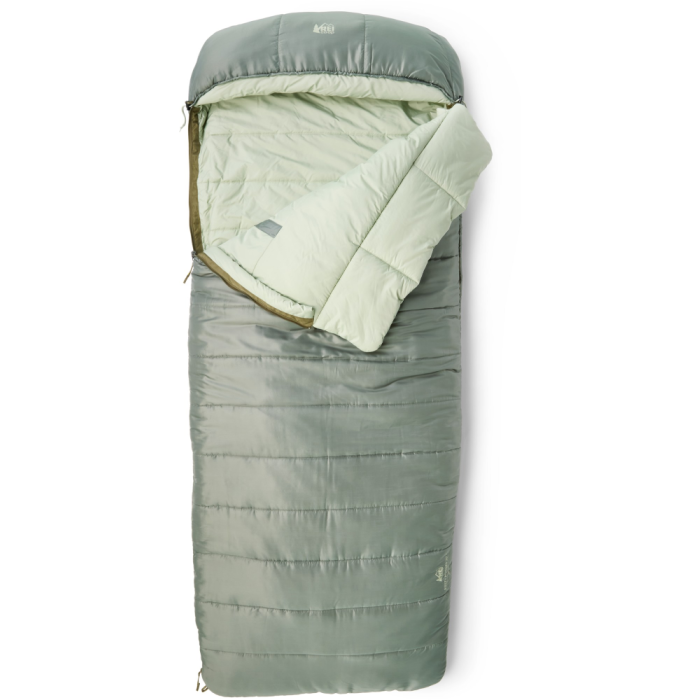
REI Siesta Hooded 20
Best Camping Sleeping Bag Overall
CleverHiker Rating: 4.9/5.0
Price: $150
Temperature Rating: 20°F
Weight: 5 lb. 7.3 oz.
Fill Type: Synthetic
Pros
- Comfy, quiet material
- Roomy rectangular fit
- Excellent value
- Inclusive sizing
- Can zip two bags together
- Huge draft collar
- Stash pocket
- Hood holds a full-size pillow
- Easy to pack
Cons
- A bit heavy
- Temperature rating is overstated
- No mesh storage sack included
- Outer material is a bit slippery
When it comes to the best camping sleeping bags out there, the REI Siesta Hooded 20 is our number one pick for 2025. It represents what we love about a quality camping sleeping bag: outstanding warmth, a spacious and comfy interior, competitive features, and stellar durability – all for a value price.
It’s easy to love this sleeping bag from the get-go because it’s just so comfy. The cinchable, rectangular hood adds extra warmth and it’s wide enough to hold a full-size pillow in place. We love the Siesta’s soft draft collar – on warm nights, flop it out like a thick blanket, or tuck it inside to block cold air.
The wide zipper is smooth, doesn’t easily catch on the material, and wraps around to the opposite corner, so you can transform it into a comforter if you prefer. It also has a partial zipper on one side to fold down the top for a bed-like sleeping experience. It’s interior pocket offers plenty of room for a phone or bulky headlamp.
We have very few complaints about the Siesta Hooded 20. It packs up a bit bulky and doesn’t come with a mesh storage sack, so storing it may be a bit challenging. But it’s not any bigger than most of the options on this list, and the oversized stuff sack is no problem for stashing or unpacking. The comfort rating is overstated – it’s cold below 35°F – but for summer weather, it’s great.
We especially love the hefty feel of this bag. It has great loft and is made of a durable material that settles around the body like a heavy blanket. The Siesta is much wider compared to most mummy bags, so regardless of your body shape, favorite sleeping position, or if you toss and turn in the night, you’ll have plenty of room to sprawl out. REI is at the top of its game with the Siesta Hooded 20. This model checks every box for us when it comes to car camping – and for this price, we think you’ll agree.
More: REI Siesta Hooded 20 Full Review
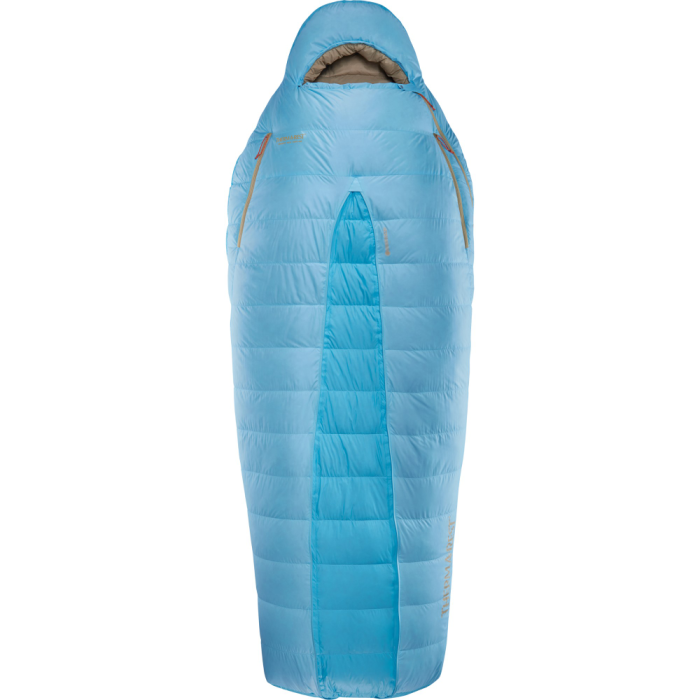
Therm-A-Rest Boost 650
Best Sleeping Bag for Features & Adjustability
CleverHiker Rating: 4.7/5.0
Price: $320
Temperature Rating: 20°F
Weight: 2 lb. 11 oz.
Fill Type: 650fp down
Pros
- Lightweight
- Expands from mummy to rectangular shape
- Two zipper vents double as arm holes
- Cozy, soft material
- Lightweight
- Packs small
- Inclusive sizing
- Mesh storage bag and compression sack included
- Dries fast
Cons
- Many zippers can feel cumbersome
- Expensive
- Shallow hood
- Comfort rating closer to 40°F and above
- Down requires a bit of extra maintenance
We welcome the unique and adjustable Therm-a-Rest Boost 650 to the top of our list. If you’re looking for an ultra-versatile sleeping bag for both cozy car camping and long backpacking trips, this one leads the pack for one-of-a-kind features, top-tier comfort and a small packed size.
Our favorite thing about this bag is a center zipper that converts the bag from a snug mummy shape – perfect for cold nights – to a wider, rectangular shape for more room on warmer nights. We also fell in love with the two smaller zippers on the sides – they double as vents, but they’re perfect for sticking our arms through. This one-of-a-kind design allowed us to stay cozy in our bags but still have dexterity to move gear around the tent, scroll our phones, or even read a book while still snuggled inside.
Also, the main zipper extends from the hood to the bottom of the footbox, so you can vent your feet better than other mummy designs. Plus, the storage is generous – the Boost 650 features one of the deepest internal pockets we’ve seen for a phone and headlamp – although it doesn’t have a closure.
Thanks to 650 fill down insulation and a durable but lightweight nylon exterior, this model also packs super small. It compresses to 20 inches by 7.5 inches in the Regular size, so we had no trouble fitting it into a backpack or trunk.
The downside of this design? The Boost 650 has a lot of zippers and features. All these zips can be overwhelming – and unnecessary – for casual car campers. Folks who just want a basic bag could spend significantly less for a simpler setup and be just as comfortable, making this level of customization feel excessive.
We also find the warmth rating is overstated. Testing in chilly temps finds it feels a bit chilly below 35-40°F, so we recommend this one for milder three-season conditions. Also the hood design, even for a mummy bag, is a bit shallow, and down insulation requires more maintenance than synthetic alternatives.
Last, the Boost 650 is spendy. However, its steep price tag reflects the unique premium feature, and we think it’s worth every penny for those who want a super durable, comfy, and adaptable bag for years of regular use. If you want an innovative design, this one is a great choice for both car camping and backpacking. It earns its keep near the top of our list for an awesome balance of warmth, comfort, features, and packability.
More: Therm-A-Rest Boost 650 Full Review

REI Trailmade 20
Most Inclusive & Accessible Camping Sleeping Bag for All Shapes & Sizes
CleverHiker Rating: 4.6/5.0
Price: $100
Temperature Rating: 21°F
Weight: 3 lb. 4.6 oz.
Fill Type: Synthetic
Pros
- Affordable
- Available in six different length & width combinations
- Smooth, two-way zipper
- Accurate temperature rating
- Comfortable material
- Recycled fill and shell materials
- Smaller packed size
Cons
- Regular width is narrow through the legs
- Cinch toggles hang close to face
- External stash pocket may not work for everyone
- No mesh storage sack
The durable, sustainably made, and warm REI Trailmade 20 hits the sweet spot for comfort and affordability. If you’re a beginner, a seasoned vet, or just looking for a budget-friendly high-performance 3-season model, this is the one for you. We love its low price, no-frills design, and huge spread of inclusive sizes- short, regular, and long, plus wide options for each length.
This thing checks all the boxes for a hybrid sleeping bag. The smooth zipper, familiar design, and soft material make for a great night of sleep. We like the external stash pocket that’s big enough for a phone or headlamp. The Trailmade packs small and is a reasonable weight – a bit over three pounds – so it’s easy to carry further to a walk-in campsite, and good for shorter backpacking adventures.
The Trailmade dovetails with other REI items that share its namesake, including a pad, tent, and more. The bag perfectly fits the Trailmade Mummy Bag Pillow, and is optimized to fit in the REI Trailmade 60 backpack.
The downsides of this bag are few. A three-pound bag is a bit heavy to take backpacking, but it could certainly work for shorter trips and those on a budget. We find it’s a bit narrow through the legs, like many similar mummy bags, so if you like to spread out when you sleep, consider going with a wide. And, the Trailmade only comes in a 20°F option, which may be too warm for hot, humid climates.
However, for those who want a well-made, durable, and comfortable sleeping mummy bag built for every body – but won’t break the bank – you can’t go wrong with the Trailmade.
More: REI Trailmade 20 Full Review

The North Face Wawona Bed 20
Most Comfortable No-Frills Sleeping Bag
CleverHiker Rating: 4.6/5.0
Price: $130
Temperature Rating: 20°F
Weight: 4 lb. 14.3 oz.
Fill Type: Synthetic
Pros
- Affordable
- Lightweight
- Smooth zipper
- Oversized zipper tab
- Comfy fleece lining at the top
- Unzips into a blanket
Cons
- No hood
- A bit heavy / bulky
- No mesh storage bag
The name of the game with The North Face Wawona Bed 20 is simplicity and comfort. If you’re looking for a cozy, no-frills sleeping bag for warm-weather camping and summer trips that will stand the test of time, the Wawona is worth a closer look.
This bag earns an Editor’s Pick badge because it walks a fine line between quality and price. For $130 you get a roomy, über comfortable sleeping bag. Our favorite part of this model is the super cozy and soft fleece lining at the top that lends next-to-skin comfort and feels like warm bed sheets. The wide rectangular shape gives it a roomy feel that makes rolling over and stretching out as easy as being in bed at home.
The Wawona features large, oversized zipper tabs that are easy to locate in the dark, and the smooth zipper track offers the freedom to vent the bag easily in the middle of the night or open it up completely to lay flat like a blanket for ventilated sleeping and staying warm around the campfire.
The Wawona is not the warmest bag in its class – it doesn’t have a hood and we also found the temperature rating felt low – we were reaching for our hats and down jackets when temperatures dropped below 40°F. That said, the Wawona is plenty warm and incredibly comfortable when overnight temps stay in the 40-60°F range.
While there’s nothing fancy about the Wawona Bed, it’s very well made, and we’re confident that it will last for years if treated with care. We recommend the Wawona Bed to those who prioritize comfort and affordability for their frontcountry trips.
More: The North Face Wawona 20 Full Review
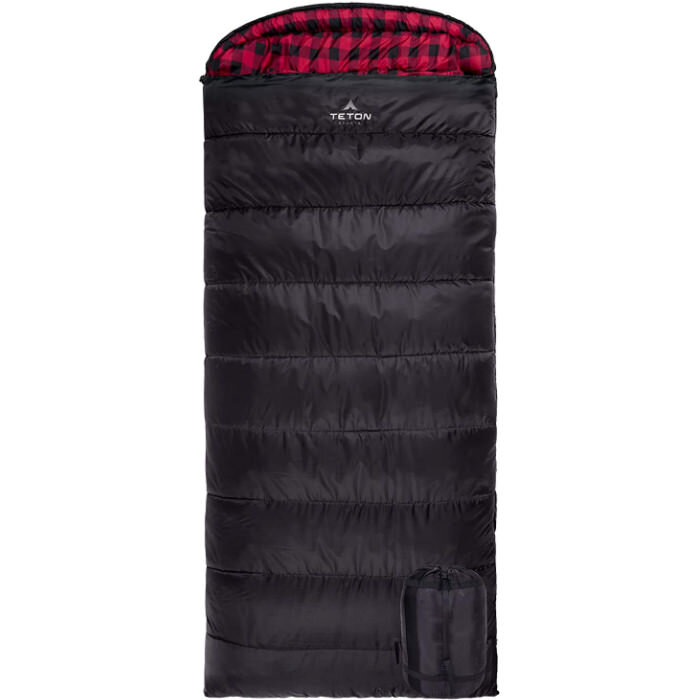
Teton Sports Celsius XXL 0F
Best Budget-Friendly Cold-Weather Sleeping Bag
CleverHiker Rating: 4.5/5.0
Price: $120
Temperature Rating: 0ºF
Weight: 7 lb.
Fill Type: Synthetic
Pros
- Wide & roomy
- Poly-flannel lining feels like bedsheets
- Affordable
- Fully unzips to turn into blanket
- Very warm
- Durable, water-resistant shell
- Large draft tubes
- Large internal pocket
Cons
- Heavier/bulkier than some
- Hood cinch cords are long
- Hood is shallow
- Zipper catches on material
- Too warm above 50°F
If you’re a cold sleeper, the Teton Sports Celsius XXL is one of our go-to’s. It’s a classic, thick sleeping bag for chilly nights at an extremely affordable price. The Celsius is better than ever thanks to significant updates, including a hood, refreshed liner material, and a new baffle design for better insulation.
Nothing beats a sleeping bag that feels like your bed back home – and the Celsius XXL nails it. The interior is a polyester and flannel lining that’s ultra-soft on the skin/ The wide, rectangular shape has tons of room for spreading out, and it’s a great choice for big and tall folks. The baffles effectively block air along the zipper and neck for cold nights, and double cinching mechanisms – one on the inside, and one for the hood – keep all the warm air inside for an extra cozy choice in cold weather.
The refreshed Celsius adds some excellent upgrades. It now includes a hood and better insulation distribution with diagonal baffles. The huge L-shaped zipper transforms the bag into a giant, cozy blanket for lounging around camp or maximum ventilation when sleeping.
The Celsius is rated to 0°F, and we tested it down to 10°F – it was so warm, heavy, and cozy, we didn’t want to get out in the morning. If you’re a cold sleeper, this thing is almost impossible to beat. That said, the temperature rating is overkill for warm and humid nights that stay 50°F and above.
Also, the hood addition is nice, but it’s a little shallow. We found the exterior fabric is a bit noisy, so if you’re sensitive to sound, this might be a bit of an annoyance. The zipper track is a bit clunky and tends to snag on the inner liner, so operating the bag is a bit tedious, especially if you need to get in or out quickly.
Lastly, the Celsius is bulky to pack up and store, although its compression sack is spacious and accommodates the material well. But, that’s exactly what we like so much about it. This is a huge, classic, comfy sleeping bag for a very reasonable price, and it’s at the top of the list because this one is a great choice for anyone who wants a super cozy and warm night of sleep.
More: Teton Sports Celsius XXL 0F Full Review
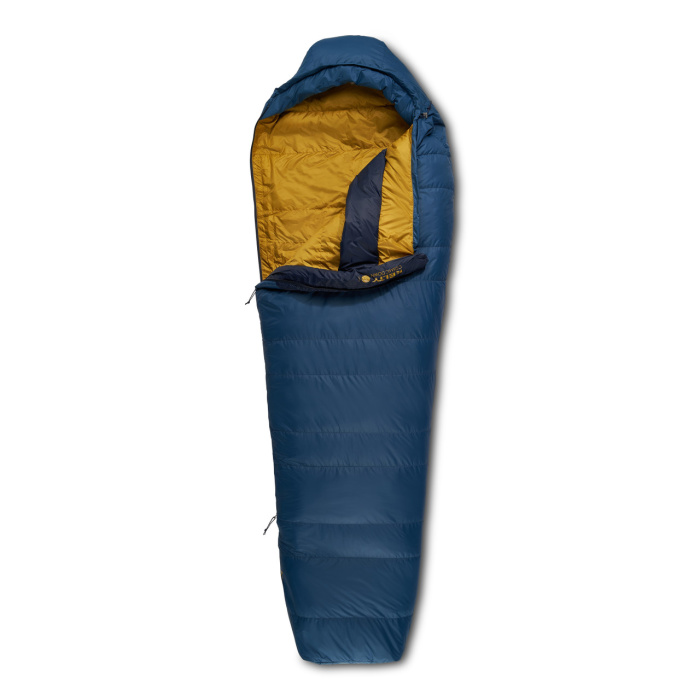
Kelty Cosmic Down 20
Value Sleeping Bag with Excellent Warmth-to-Weight
CleverHiker Rating: 4.5/5.0
Price: $170 / $190
Temperature Rating: 21ºF
Weight: 2 lb. 7 oz. / 3 lb. 4.8 oz.
Fill Type: 550fp down
Pros
- Excellent value for a down sleeping bag
- Lightweight
- Packs small
- Hood adds warmth
- Strong, snag-free zipper
- Warm
- Zippered stash pocket
Cons
- Narrow fit
- Women’s bags cost and weigh more
- Down requires special care when washing
- Does not include mesh storage bag
Whether you’re car camping in the Poconos or setting up a basecamp in the Sierras, Kelty’s über popular mummy-style Cosmic Down 20 (men’s / women’s) is a stellar choice for a sound night of sleep.
We’re big fans of the quality, fast-drying fabrics on the Cosmic Down 20. The slim-fitting mummy bag design is more efficient at retaining heat versus rectangular options, since the footbox is rounded and there are no corners for cold spots. This combination of fabrics and warmth makes the Cosmic a great choice for camping in humid, foggy, and damp conditions. Plus, it comes in 0°, 20°, and 40°F options that will work for whatever season you’re camping in.
The ergonomic footbox gives a bit of extra wiggle room for your toes, and the Cosmic has one of the larger zippered stash pockets we’ve seen – plenty big enough for your phone, watch, and chapstick. We also appreciate this bag’s slightly wider fit, so those with larger body sizes or who dislike slim or narrow sleeping bags will appreciate the bit of extra room.
The main complaint we have about this model as a camping bag is it’s a narrow fit compared to most on this list. This is a traditional mummy bag, so it’s perfect for staying warm since there’s no extra space or dead corners to collect cold – making it a solid crossover pick for both backpacking and car camping. That said, if you prefer to spread out, or will be staying in the frontcountry for most of your camping experiences, this may not be the best option compared to more spacious synthetic bags on this list.
It’s a bit on the heavy side for longer backpacking trips. These models are very light for car camping and shorter backcountry trips, but they’re hefty side if you’re trekking longer than a few days. Check out the Ultralight version to save weight. It ranks well on our Best Backpacking Sleeping Bags guide.
Last, this Kelty model also has one of the largest gender price discrepancies – and weight differences – we’ve seen in any product category. The women’s bag does include more down in the chest and hips for cold nights and extra padding, but it costs $40-$70 more than the men’s version, and weighs a whopping 13 ounces more.
That said, Kelty has a real winner for car camping with the Cosmic Down that we continue to use year after year from late spring until early fall. With a price range of $150 – $190, this well-rounded down bag is an accessible, affordable sleeping option for cool nights.
More: Kelty Cosmic Down 20 Full Review
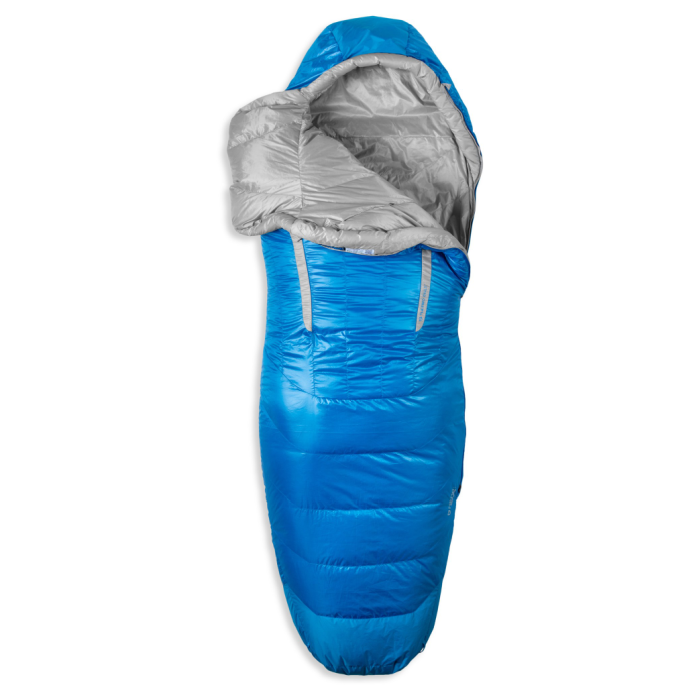
NEMO Disco Endless Promise 30
Versatile Down Bag for Summer Camping & Backpacking
CleverHiker Rating: 4.4/5.0
Price: $270
Temperature Rating: 30°F
Weight: 1 lb. 15 oz. / 2 lb. 4 oz.
Fill Type: 650fp down
Pros
- Manufactured with recycled & recyclable materials
- Lightweight
- Wide fit for side & belly sleepers
- Vents to assist breathability
- Men’s and women’s versions zip together
- Built-in pillow sleeve
- Compression sack & stuff sack included
- Good for both backpacking & camping
Cons
- Expensive
- Larger packed size
- Down requires special care when washing
- May be excessive for car camping
- Most comfortable 45°F or higher
If you’re on the hunt for a backcountry-worthy camping bag that’s wide enough to accommodate belly sleepers and side sleepers, the NEMO Disco 30 (men’s / women’s) is for you. Those who prioritize comfort and tons of legroom at a decently low weight will love the Disco for its roomy and unrestricted interior.
When it comes to temperature control, this bag is king. It features two super-functional ThermoVent “gills”, basically two mesh-lined zippers on top of the bag. When open, these vents dump hot air and allow cool air in without needing to unzip the bag lengthwise. We also like that the massive oversized draft collar blocks cool air from getting into the bag on cool nights.
We love the Disco for its unique, spacious spoon shape that gives plenty of room around the elbows and knees. At just over two pounds for Regular and packing impressively small, the Disco is a perfect crossover bag: cozy for car camping, but a solid choice for backpacking adventures.
NEMO leads the pack for sustainability with the Disco. The Endless Promise namesake is NEMO’s commitment to keeping materials out of landfills with fully recyclable products. When the days of your Disco are done, send it back to NEMO – they take full responsibility for recycling all parts of this bag, from fabric to the zipper. Even the shell is made from 100% recyclable PET.
The listed temperature rating is a tolerable minimum, not a comfort rating. Though the Disco 30 kept us warm to around 45°F, we found there was a sharp drop off in comfort below that. For 40°F and below, we recommend sleeping in your base layers. If you’re a cold sleeper, we recommend the 15°F model instead. Or, if your camping partner has a Disco, the two bags can be zipped together to maximize heat retention.
Finally, it may simply be too much for occasional or casual car campers. It’s worth noting that NEMO’s attention to detail is exceptional, but many of these features go unused unless you’re also backpacking. However if you plan to do a mix of backcountry and frontcountry trips, and want a roomy bag, it’s worth paying a bit more for an excellent quality option like the NEMO Disco 30. It’s the best of both worlds for car camping and backpacking.
More: NEMO Disco Endless Promise 30 Full Review

The North Face One Bag
Best Sleeping Bag for Different Temperatures
CleverHiker Rating: 4.3/5.0
Price: $350
Temperature Rating: 5°F, 20°F, 40°F
Weight: 3 lb. 13 oz.
Fill Type: Hybrid: 800fp down & synthetic
Pros
- Versatile for different temperatures
- Warm
- Wide fit for tossing & turning
- Comfortable material
- Packs small
- Durable build
- Large draft collar
- Glow-in-the-dark zipper pulls
- Fleece-lined stuff sack doubles as pillow
Cons
- Expensive
- Wrap-around zippers add stiffness to bag
- No internal pocket
- Length runs a bit short
- Thin on the underside (warm sleeping pad required)
If you’re a car camper, weekend backpacker, or year-round adventurer looking for the ultimate hybrid 3-season camping bag, look no further than The North Face One Bag. This model has three different temperature ratings of 5°F, 20°F, and 40°F that will keep you warm and comfy from below-freezing winter nights to balmy summer evenings.
We’re always a bit wary of products that try to do multiple things at once. But, like its name implies, The One succeeds at being the only bag you’ll need year-round. We’ve used it from deep-freeze winter backpacking trips to balmy summer adventures, and it’s performed admirably.
Thanks to a unique layered zipper system and a hybrid of down and synthetic insulation, The One is warm down to 15° F. It’s super cozy, so you can snuggle into the depths of the comfy material and stay toasty when the temps drop. In warmer conditions, zip off the top layer for comfortable sleeping in 30 – 45°F. And in warm conditions (>50°F), unzip the mid layer for ultimate breathability.
The One bag also stands out for its build quality and attention to detail. The wide fit allows for easy movement, which is great for tosser-turners. Zipper pulls are glow-in-the-dark for easy access. We love that the stuff sack doubles as a pillow – its interior is lined with fleece – and the draft collar is fluffy and effective at keeping cold air out.
On the downside, we could feel the stiff structure of the zippers on all sides of the bag. This wasn’t a dealbreaker, but it took a bit of getting used to. The bag length is a bit short, so you may want to size up to a Long version. Also, most of the insulation is on top of the bag – not the underside – so if you’re planning to camp in really cold conditions, be sure to use a warm sleeping pad or camping mattress with a high R-value.
And, for $350, this is one of the most expensive sleeping bags we tested – but its versatility makes it a value that’s tough to beat. Considering it would take at least two sleeping bags to feel cozy in such a huge temperature range, The One Bag is an extremely practical choice, and a smart investment with years of payoff.
If your priority is a sleeping bag that handles a huge range of temperatures, offers a comfortable, wide fit, and will last for year after year – The North Face The One is the one for you.
More: The North Face One Bag Full Review

Kelty Tru.Comfort 20 Doublewide
Best 2-Person Camping Sleeping Bag
CleverHiker Rating: 4.1/5.0
Price: $200
Temperature Rating: 20°F
Weight: 9 lb. 8 oz.
Fill Type: Synthetic
Pros
- Affordable
- Oversized hood fits two full-size pillows
- Top layer zips off
- 2 extra blankets add warmth
- Spacious for two people
- Ventilating wrap-around zippers on each side
- Durable, soft material
- Oversized stuff sack
Cons
- Heavy / bulky
- Liner fabric is a bit slippery
- Simple feature set
- Cold below 45°F
- Blankets a bit small
The impressively cozy and cleverly designed Kelty Tru.Comfort 20 Doublewide is perfect for those who want to share a sleeping bag with their bae or best four-legged friend. If you sleep best in a shared space, the Doublewide shows there’s no need to sacrifice this arrangement just because you’re sleeping under the stars.
The Tru.Comfort Doublewide offers unique, comfy features for two people without sacrificing personal comfort. It includes two separate integrated blankets so each person can have their own, adding a warm but lightweight extra layer on chilly nights. The huge oversized hood accommodates two full-sized pillows from home so you can bring the creature comforts with you. And, this bag is the definition of roomy: it’s wider than a Queen mattress, so you can still sleep like a starfish – as long as your partner doesn’t mind.
We also appreciate the Tru.Comfort’s versatile wrap-around zipper system. When that game of footsie gets too hot, simply unzip the bottom of the bag to let your feet breathe. On especially toasty nights, we like that the entire upper layer can completely zip off for an airier, cooler sleeping experience.
There are a few downsides to this Kelty model. We find the Tru.Comfort’s 20°F temperature rating is overstated. In our testing, even with shared body heat, this bag felt chilly on nights below 45°F. And while we like the blankets, they aren’t wide enough to offer full coverage for most adults. That’s why we recommend reserving this double bag for your June to September trips.
The U-shaped zipper could feel a bit cumbersome to unzip in the middle of the night, and it’s missing more premium features like pockets, a cinch cord, and sleeping pad pocket. We find the material is a bit slippery, so if you’re sensitive to texture, this one may miss the mark. And, the Tru.Comfort packs up bulky – but to be fair, this is a sleeping bag for two, so a large packed size is not a dealbreaker for us, and it takes up about the same amount of space as two separate bags.
That said, we highly recommend the Kelty Tru.Comfort. It hits the nail on the head when it comes to a shareable sleeping bag for two and the $200 price tag is a sweet deal for years of comfy camping.
More: Kelty Tru.Comfort 20 Doublewide
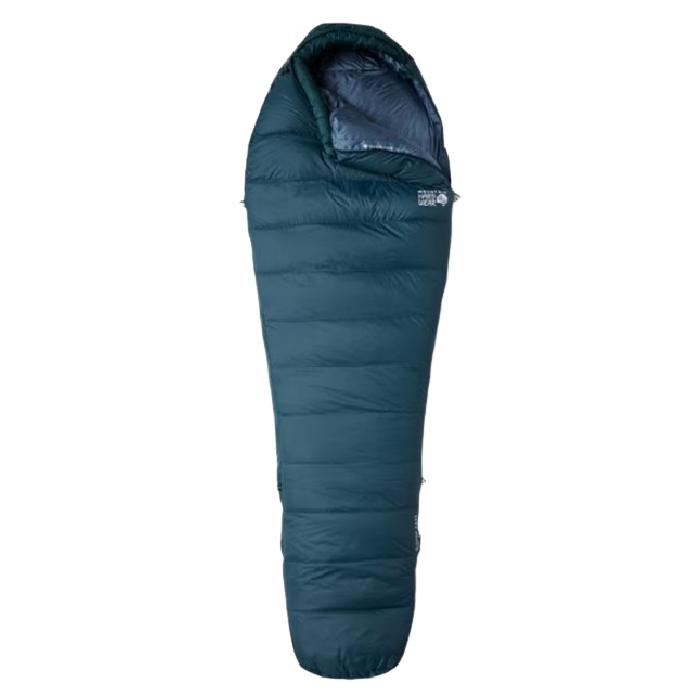
Mountain Hardwear Bishop Pass 15
Best Crossover Sleeping Bag
CleverHiker Rating: 4.2/5.0
Price: $285
Temperature Rating: 15°F
Weight: 2 lb. 5.4 oz.
Fill Type: 650fp down
Pros
- Outstanding value for a down bag
- Good warmth-to-weight ratio
- Smooth zipper that doesn’t catch on material
- Lightweight
- Overstuffed footbox
- Packs small
Cons
- Slippery / slightly loud material
- Down requires special care
- Internal stash pocket is small with no closure
For those looking to step into the world of down sleeping bags the Mountain Hardwear Bishop Pass 15 is top-tier. This excellent all-around down bag has kept us warm through backpacking trips in Rocky Mountain National Park, the deep canyons of Utah, and dozens of car camping adventures.
We love the lightweight compressibility of the Bishop Pass. With a packed size that easily fits in any backpack and a weight under 2.5 pounds, the Bishop Pass represents one of the best warmth-to-weight ratios on this list.
This mummy bag is simple – but it does simple very well. The Bishop Pass has a smooth zipper that rarely catches on the bag material. The draft collar is wider on the sides and narrower in the middle to wrap naturally around your neck and prevent cold drafts. The footbox has an ergonomic shape with a bit more down filling on the underside so you won’t experience cold spots, and we find the hood is deep enough for most backpacking pillows and cinches up nicely to retain warmth around our heads.
The main issue we encountered with this bag is the slipperiness and the sound of the material – both qualities more noticeable than in previous versions, but we got used to it pretty quickly. The comfort range of this bag is closer to 25°F than 15°F, so for truly cold nights, we found an extra base layer made a world of difference. We appreciate that Mountain Hardwear includes a pocket, but it’s too small for a phone, and the lack of a closure means small items tend to slip out at night.
Still, the Bishop Pass earns its keep on our list. It’s an affordable, durable, and practical mummy bag for beginners and seasoned veterans looking for a down bag for backpacking, car camping, and everything in between. Plus, it comes in Gore Tex, 0° and 30° versions, so wherever you’re headed next, this bag will keep you warm and comfortable.
More: Mountain Hardwear Bishop Pass 15 Full Review

NEMO Jazz 30 Double
Luxury Sleeping Bag for Two with Excellent Features
CleverHiker Rating: 4.0/5.0
Price: $350
Temperature Rating: 30°F
Weight: 8 lb. 14.7 oz.
Fill Type: Synthetic
Pros
- Bed-like feel
- Hood holds 2 full-size pillows in place
- Spacious for 2 people
- Oversized storage case is easy to use
- Integrated polyester bedsheet
- Smooth, non-intrusive wrap-around zipper
- Comfortable material
- Oversized, plush draft collar
- Integrated sleeping pad sleeve
Cons
- Heavy / bulky packed size
- Expensive
- Bedsheet detaches easily with movement
If you’re looking for a two-person sleeping bag that feels like your bed at home, the NEMO Jazz 30 Double is the gold standard. The Jazz 30 Double has earned its place thanks to its outstanding quality and awesome features.
The best part? The Jazz 30 Double’s polyester bed sheet. This element truly makes it feel like a bed. The downside is it doesn’t stay attached for long due to a weak button system – if both people move around, the sheet comes unsnapped. That said, its plush feel and added warmth are a nice touch. With a massive, wide draft collar to block out cool air and a huge oversized hood that fits two full-size pillows from home, this new addition to our list is an outstanding solution for car campers and weekend warriors looking for a cozy sleep system to share.
A tapered footbox reduces dead space for each person while still giving plenty of room to spread out. Burly, no-snag side zippers extend from head to toe to vent your feet when it gets hot, and you can enter and exit the bag without disturbing your partner. One of our all-time favorite sleeping mattresses, the NEMO Roamer Double, integrates with the sleeping pad pocket on the bottom of the Jazz for a super luxurious night of sleep.
The main reason it’s further down the list is its steep price tag. At $350, the Jazz Double is one of the spendier models. The Kelty Tru.Comfort 20 offers a similar 2-person sleeping bag for quite a bit less, although this one is cushier and more comfortable. And, keep in mind you’re essentially getting two very high-quality sleeping bags in one – two separate bags could easily cost more.
Additionally, the Jazz Double’s packed size is huge. The stuff sack is a large duffel bag with oversized handles, so it’s easy to pack up, but you’ll need ample room in the car and at home for storage.
Still, this thing is as boujee as a sleeping bag gets. The Jazz 30 Double is a bed-like sanctuary for couples, families, and dog lovers who want to share a sleeping bag and are looking for the ultimate in cocoon-like warmth.
More: Jazz 30 Double Full Review
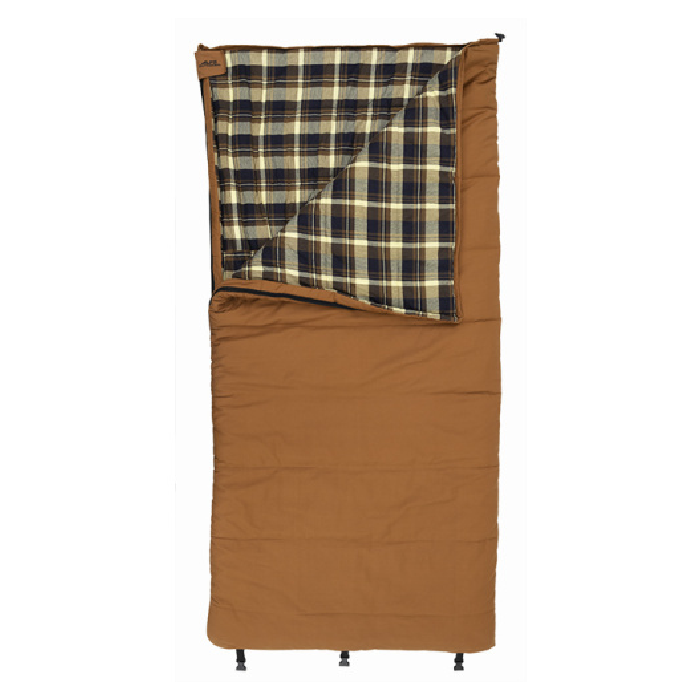
ALPS OutdoorZ Redwood -10
Best Classic Heavyweight Sleeping Bag
CleverHiker Rating: 3.9/5.0
Price: $160
Temperature Rating: -10°F
Weight: 11 lb. 8 oz.
Fill Type: Synthetic
Pros
- Very warm
- Heavy like a weighted blanket
- Soft interior fabric
- Durable exterior canvas material
- Affordable
- Roomy & wide fit
- Cushy insulation
- Completely unzips into blanket
Cons
- Often out of stock
- No hood
- Very heavy & bulky packed size
- Absorbs water & condensation
- No stuff sack
For cold-weather car campers, hunters, year-round adventurers, and anyone who loves a classic, super warm sleeping bag for nights in frigid temps, the Alps OutdoorZ Redwood -10°F is a great choice.
A night in the Redwood feels like sleeping inside of a weighted comforter: it’s heavy, huge, and very cozy. The wide orientation is perfect for any sleeping style, allowing you to sprawl out as wide as you need. We especially love the nostalgic flannel lining, which adds a bit of old-school warmth and outstanding coziness. It can be unzipped completely to be turned into a thick blanket for two, or you can zip two Redwoods together for shared warmth.
The Redwood is incredibly toasty, ranking as one of the warmest bags on this list. However, this bag has a sweet spot when it comes to temperature. Despite the generous -10°F rating, we found that in temperatures below 5°F, the Redwood began to feel a bit chilly, and in temperatures above 35°F, we were sweating. It’s perfect for folks who are active outside in the coldest of the cold shoulder seasons, but it’s much too warm for summer.
The burly exterior canvas is one of our favorite parts about the Redwood. It holds up extremely well against abrasion and will last for years. However, this exterior is also a downside of the Redwood: it’s made of a cotton blend that’s water resistant – until it isn’t, when it absorbs water like dry soil. That said, it dries fairly quickly in arid mountain and desert settings.
Also, this model is huge. It’s about 11.5 pounds and packs to about three feet by one foot. You’ll have to account for its size when packing the car or storing it over the summer. This bulkiness is a byproduct of the warmth it offers, and you’ll be getting one of the toastiest bags out there.
The main reason this one’s near the bottom of our list is the -10 version is in stock for only half the year. You’ll need to jump on it if you see it ready to ship. The Redwood -10 is usually available in spring and the fall, but timing can be annoying.
If you’re looking for one of the heaviest and most comfortable cold-weather sleeping bags on the market, the classic, no-frills Redwood -10 is unrivaled. You’re all but guaranteed a terrific night of sleep in this thing, as long as the temperatures are well below freezing.
More: ALPS OutdoorZ Redwood -10F Full Review
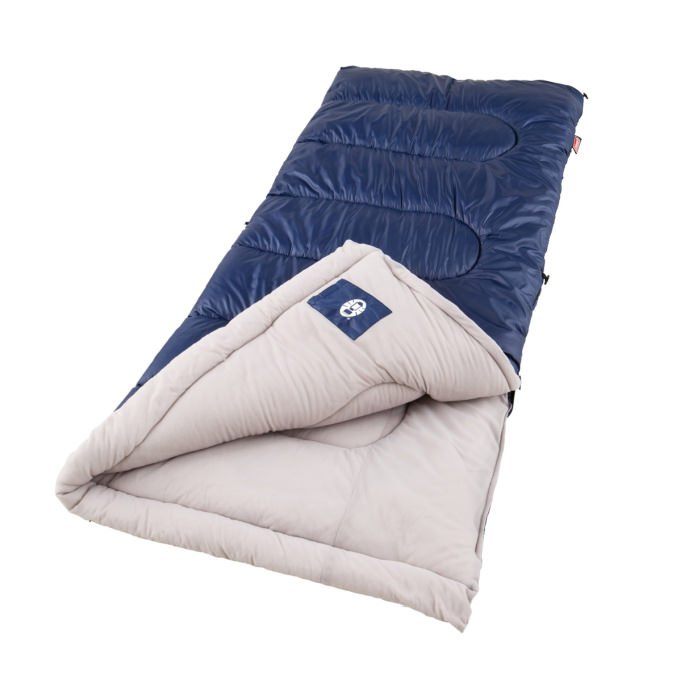
Coleman Brazos 30
Best Budget Camping Sleeping Bag
CleverHiker Rating: 3.7/5.0
Price: $47
Temperature Rating: 30ºF
Weight: 5 lb. 2.9 oz.
Fill Type: Synthetic
Pros
- Very affordable
- Comfortable interior material
- Durable
- Internal stash pocket
- Fully unzips to turn into a blanket
- Zip two bags together for more room
Cons
- Heavier/bulkier than some
- Debris and clothes snag on inner fabric
- Challenging to pack
- No hood or cinching mechanism
- Not water resistant
If you’ve got a slim wallet or need multiple sleeping bags, the Coleman Brazos 30 is your best bet. It’s hands down the most affordable sleeping bag on this list and one of our top budget picks.
The Coleman Brazos is a minimalist sleeping bag that offers exactly what we want in a sleeping bag and nothing more. It’s warm enough for nights 45ºF and above, perfect for mild weather and summer conditions. We like the cushy interior tricot fabric that feels buttery soft against the skin. That said, you’ll need to be a bit careful with this fabric, as it tends to pick up debris easily if it comes in contact with the ground, and it can feel a bit clingy against baselayers on cold nights.
The boxy and rectangular shape is well-suited for larger bodies and those who move around in the night, and the L-shaped zipper allows you to completely open up the bag into a blanket. Plus, two Brazos can be zipped together to share warmth.
That said, you’ll make some sacrifices with a $50 sleeping bag. It has small draft tubes and there’s no hood or tightening mechanism at the top. The zipper tends to catch on the material, which can be frustrating at night. Also, the exterior isn’t water resistant, so we don’t recommend it for wet or humid climates, and condensation can be an issue.
The biggest challenge, though? The Brazos is challenging to pack up. It takes work to fit it back into the tight stuff sack, though Coleman has some thin cord at the bottom of the back to contain the bag. Our testing finds neither of these systems are worth the time – instead, consider purchasing an inexpensive mesh laundry bag to toss this model inside for easy storage.
However, budget-friendly products are Coleman’s wheelhouse, and the Brazos offers a solid value for the price. It’s a comfortable, practical sleeping bag that will keep you warm on cool summer nights, and it’s a good option if you camp just a few times a year, need a reliable backup bag, or simply want to get outside without spending an arm and a leg.
More: Coleman Brazos 30 Full Review

Exped Megasleep Uno 25/40
Lightweight Sleeping Bag for Summer Nights
CleverHiker Rating: 3.5/5.0
Price: $150
Temperature Rating: 25ºF / 40ºF
Weight: 3 lb. 12 oz.
Fill Type: Synthetic
Pros
- Affordable
- Lightweight
- Comfortable lining material
- Two temperature options depending on which side faces up
- Completely unzips into blanket
- No-frills design
- Dries fast
Cons
- No hood
- Cold in below freezing temps
- Zipper durability is questionable
- Pocket is flimsy and doesn’t have a closure
The Exped MegaSleep Uno 25/40 is a good choice for summer camping. It’s a practical, airy, and comfy sleeping bag that’s built for nights between 40-60°F. The Uno offers a simple and clever way to moderate your temperature: use its burgundy side (with extra fill) on top to keep you a bit warmer in temperatures in the mid-forties to mid-fifties, or flip it over and use the blue side (with less fill) facing up for more breathability on warm summer nights in the fifties and sixties.
This is one of the lighter synthetic bags on our list, and packs to an average size. We love the soft interior liner and simple feature set, including a cinch cord at the neck and a pocket, and it’s plenty wide and long enough for all body shapes and sizes.. The quick-drying microfiber insulation gives the Uno loft but keeps the profile very slim and awesomely easy to pack. This model also completely unzips into a blanket for kicking it around the campfire, or you can open it up to get the most breathability during warm nights.
Our biggest complaint about the Uno is durability – the zippers broke off the track early on in testing, which turned the bag into a permanent blanket. This doesn’t seem to be a common issue, but we ranked the bag near the bottom of our list as a result.
Additionally, the MegaSleep’s not warm enough for below-freezing fall or spring conditions. It doesn’t have a hood and the draft tubes are fairly narrow. But it really shines on mild summer nights, where it’s our go-to as a breathable, soft, and versatile option.
Still, this bag makes this list because it’s super affordable and comfortable. If you generally sleep hot, love summer camping, and prefer a bag that’s streamlined, compact, and has an airy feel, the Uno is an excellent fit for car camping.
More: Exped Megasleep Uno 25/40 Full Review
Product Comparison Table
| oSort | Product | Price | Temperature Rating | Weight | Fill Type | Comfort | Warmth | Packed Size | Features | 0 |
REI Siesta Hooded 20 View at REI |
$150 | 20°F | 5 lb. 7.3 oz. | Synthetic | 4.8 | 4.3 | 4.5 | 4.7 | 1 |
Therm-A-Rest Boost 650 View at REI View at Amazon |
$320 | 20°F | 2 lb. 11 oz. | 650fp down | 4.7 | 4.5 | 4.7 | 5 | 2 |
REI Trailmade 20 View at REI |
$100 | 21°F | 3 lb. 4.6 oz. | Synthetic | 4.5 | 4.3 | 4.6 | 4.2 | 3 |
The North Face Wawona Bed 20 View at REI View at Amazon |
$130 | 20°F | 4 lb. 14.3 oz. | Synthetic | 4.4 | 4.2 | 4.5 | 4.1 | 4 |
Teton Sports Celsius XXL 0F View at Amazon View at Target |
$120 | 0ºF | 7 lb. | Synthetic | 4.7 | 4.8 | 3.3 | 4.3 | 5 |
Kelty Cosmic Down 20 View Men's View Women's |
$170 / $190 | 21ºF | 2 lb. 7 oz. / 3 lb. 4.8 oz. | 550fp down | 4.3 | 4.6 | 4.9 | 4.3 | 6 |
NEMO Disco Endless Promise 30 View Men's View Women's |
$270 | 30°F | 1 lb. 15 oz. / 2 lb. 4 oz. | 650fp down | 4.8 | 4.4 | 4.7 | 4.8 | 7 |
The North Face One Bag View at Amazon View at Backcountry |
$350 | 5°F, 20°F, 40°F | 3 lb. 13 oz. | Hybrid: 800fp down & synthetic | 4.4 | 4.2 | 4.5 | 4.1 | 8 |
Kelty Tru.Comfort 20 Doublewide View at REI View at Amazon |
$200 | 20°F | 9 lb. 8 oz. | Synthetic | 4.6 | 4.2 | 3.5 | 4.5 | 9 |
Mountain Hardwear Bishop Pass 15 View at REI View at Amazon |
$285 | 15°F | 2 lb. 5.4 oz. | 650fp down | 4.5 | 4.7 | 4.8 | 4.2 | 10 |
NEMO Jazz 30 Double View at REI View at Amazon |
$350 | 30°F | 8 lb. 14.7 oz. | Synthetic | 4.8 | 4.2 | 3.6 | 4.9 | 11 |
ALPS OutdoorZ Redwood -10 View at Amazon View at Scheels |
$160 | -10°F | 11 lb. 8 oz. | Synthetic | 4.7 | 4.9 | 3.0 | 3.8 | 12 |
Coleman Brazos 30 View at REI View at Amazon |
$47 | 30ºF | 5 lb. 2.9 oz. | Synthetic | 4.1 | 4.1 | 3.4 | 3.9 | 13 |
Exped Megasleep Uno 25/40 View at REI View at Amazon |
$150 | 25ºF / 40ºF | 3 lb. 12 oz. | Synthetic | 4.4 | 4.5 | 4 | 3.7 |
|---|
How We Test & Methodology
We test camping sleeping bags along four different dimensions – warmth, comfort, packed size, and features – to assess and compare performance.
COMFORT
For sleeping bag comfort, we evaluate the bag’s shape and size, looking at how mummy, rectangular, and hybrid designs accommodate different sleeping styles and body types. We assess the softness of the interior fabric for its against-the-skin comfort. We also examine how roomy a sleeping bag is, particularly in the shoulders and through the foot box, to make sure there’s enough space to turn over. We test the effectiveness of the zipper system for ease of use and snag resistance, as a smooth-operating zipper enhances overall comfort.
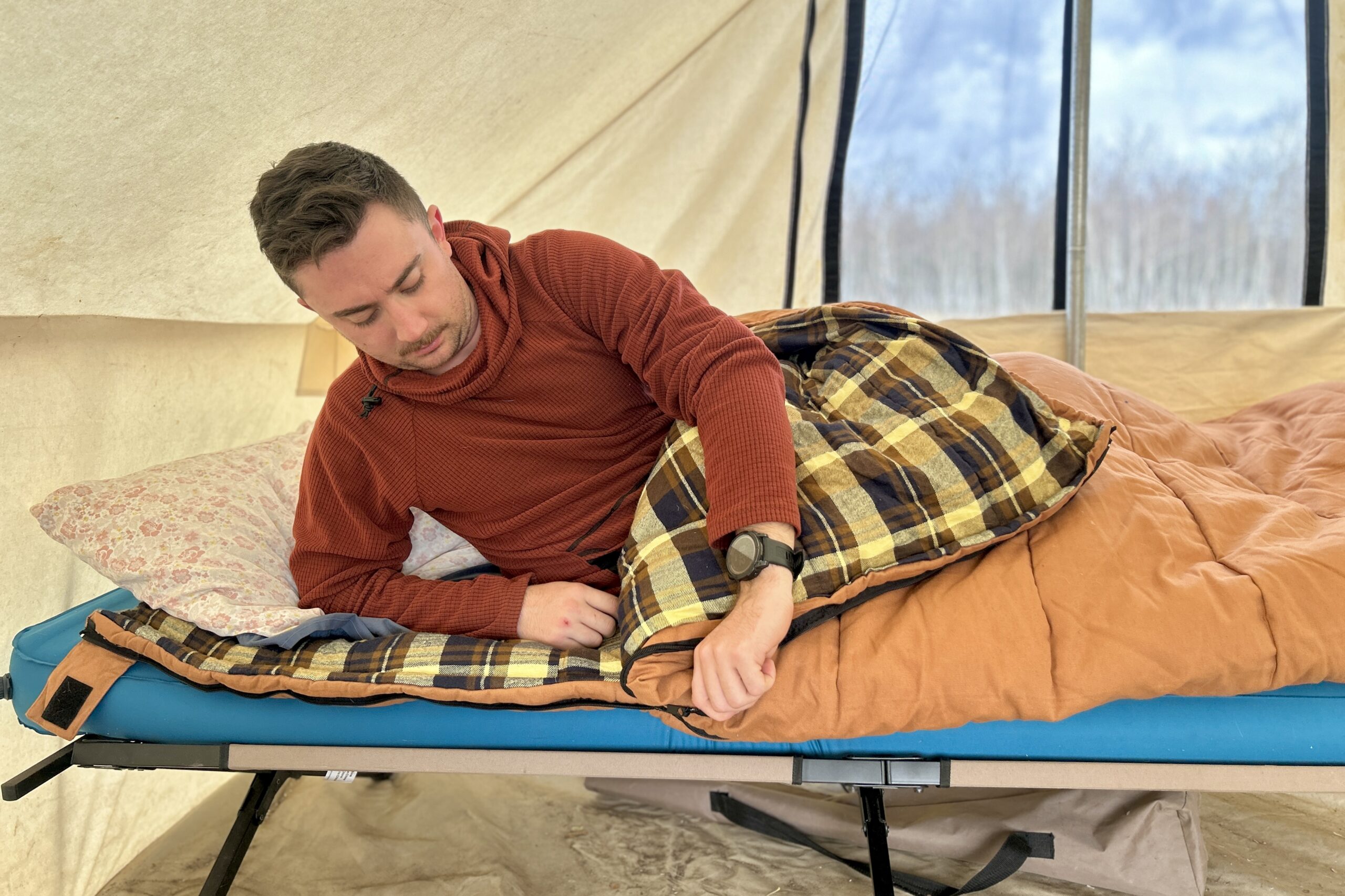
WARMTH
For warmth, we test the sleeping bags in all sorts of conditions, from 0°F to upwards of 70°F to verify temperature ratings are accurate and a bag is reliable. Additionally, we assess the design features that help retain warmth while you sleep, like draft collars, hoods, zipper baffles, and baffle shape which are crucial in preventing heat loss. We also consider the shell material’s durability and water resistance, as these elements protect the insulation and maintain warmth in damp conditions. We also evaluate the fill loft and weight of each bag, (a higher loft and higher fill weight indicate better insulation and warmth).
PACKED SIZE
Packed size is less of a priority for camping than backpacking but size still matters for storage and transport. We look at the type of insulation and its loft, looking for high-loft down and advanced synthetic fills that compress well to save space in the trunk. Next, we measure the packed dimensions and weight and also consider if the sleeping bag uses compression sacks, straps, or a stuff sack that can dramatically reduce its volume without damaging the insulation.

FEATURES
When it comes to features on sleeping bags, we start by assessing internal and external pockets, evaluating their size, placement, and accessibility for storing small items like phones, chapstick, and headlamps. We look at the functionality of wrap-around zippers, ensuring they provide versatile ventilation options and easy entry and exit, and glow-in-the-dark zipper pulls earn extra points for visibility and ease of use in low-light conditions, adding convenience for nighttime adjustments. We also consider extra features like built-in pillow attachments, pad attachments, and torso or foot vents that contribute to the sleeping bag’s comfort and usability.
Why Trust CleverHiker
Our team at CleverHiker has collectively spent over a thousand nights under the stars, testing sleeping bags from sticky 80°F summer evenings in the Sonoran desert to -10°F winter nights in the high Rockies. Ian Krammer, Gear Analyst and lead camping sleeping bag tester, has been camping and sleeping outdoors all over the Rocky Mountains of Colorado for the last decade. With a deep love for the outdoors and years of product sales and analysis experience, he has a keen eye for quality gear. His systematic approach of putting sleeping bags through the wringer in real-world conditions, along with a critical eye towards quality, guarantees these sleeping bags will provide a stellar night of sleep in any conditions.
Analysis & Results
We outline the results of our testing process below and discuss top performers for warmth, comfort, packed size, and features.
VALUE
We look for sleeping bags that deliver top-tier performance to make sure you get the most out of your investment – regardless of the price tag. Although some sleeping bags are just downright less expensive with above-average performance, premium bags can often pay off in the long run with extended durability and higher quality.
We’re huge fans of the REI Trailmade 20. This model offers an awesome value for only $100 – it’s comfy, warm, comes in a ton of inclusive sizes, and is lightweight enough for both car camping and short backpacking trips. We like the simple feature set, quiet material, and lightweight construction, making it a fantastic choice for campers who want flexibility on a budget.
Also consider the Teton Sports Celsius XXL 0°F. This is one of the warmest, most spacious bags we’ve ever tested for such a competitive price. The extreme cold-weather capability and crazy durability of this one makes it an outstanding value for those needing a larger, ultra-warm bag. Rated for 0°F, its massive loft is built for the coldest temperatures and the fleece-lined interior rivals our favorite cold-weather sheets at home. Despite its large size, the Celsius XXL remains affordably priced for exceptional warmth.
Finally, The North Face One Bag offers unparalleled value with its innovative modular design. This is one of the most expensive bags on our list, but it’s essentially 3 bags in one thanks to a layering system built for a huge range of temperatures: 5°F, 20°F, and 40°F. Its combination of synthetic and down layers can be used together or separately in mild to sub-zero conditions. The versatility and performance it offers is a cost-effective investment for serious adventurers who camp year round.
COMFORT
When it comes to spaciousness and room to move, our top choices are the ALPS OutdoorZ Redwood -10, the Teton Sports Celsius Grand XXL 0F, and the REI Siesta Hooded 20. All of these bags are rectangular shaped – as opposed to more restrictive mummy bags – so they provide a ton of extra space to toss, turn, stretch out, and change positions while you sleep.
That said, the NEMO Jazz Double and the Kelty Tru.Comfort 20 are the most spacious sleeping bags on our list since they’re designed for two people – or one person and a dog – who want a comfortable shared sleeping experience.
We prioritize bags with soft interior linings to maximize comfort, which is also where the ALPS OutdoorZ Redwood -10 and the Teton Sports Celsius Grand XXL 0F stand out. They feature soft internal linings, whether synthetic material, flannel, or brushed flannel that offer a cozy, bed-like feel. The REI Siesta earns top marks for comfort too, thanks to a giant blanket-fold feature that zips down partially on both sides for a blanket-like feel that adds a bit of extra warmth and comfort for a snuggly night of sleep.
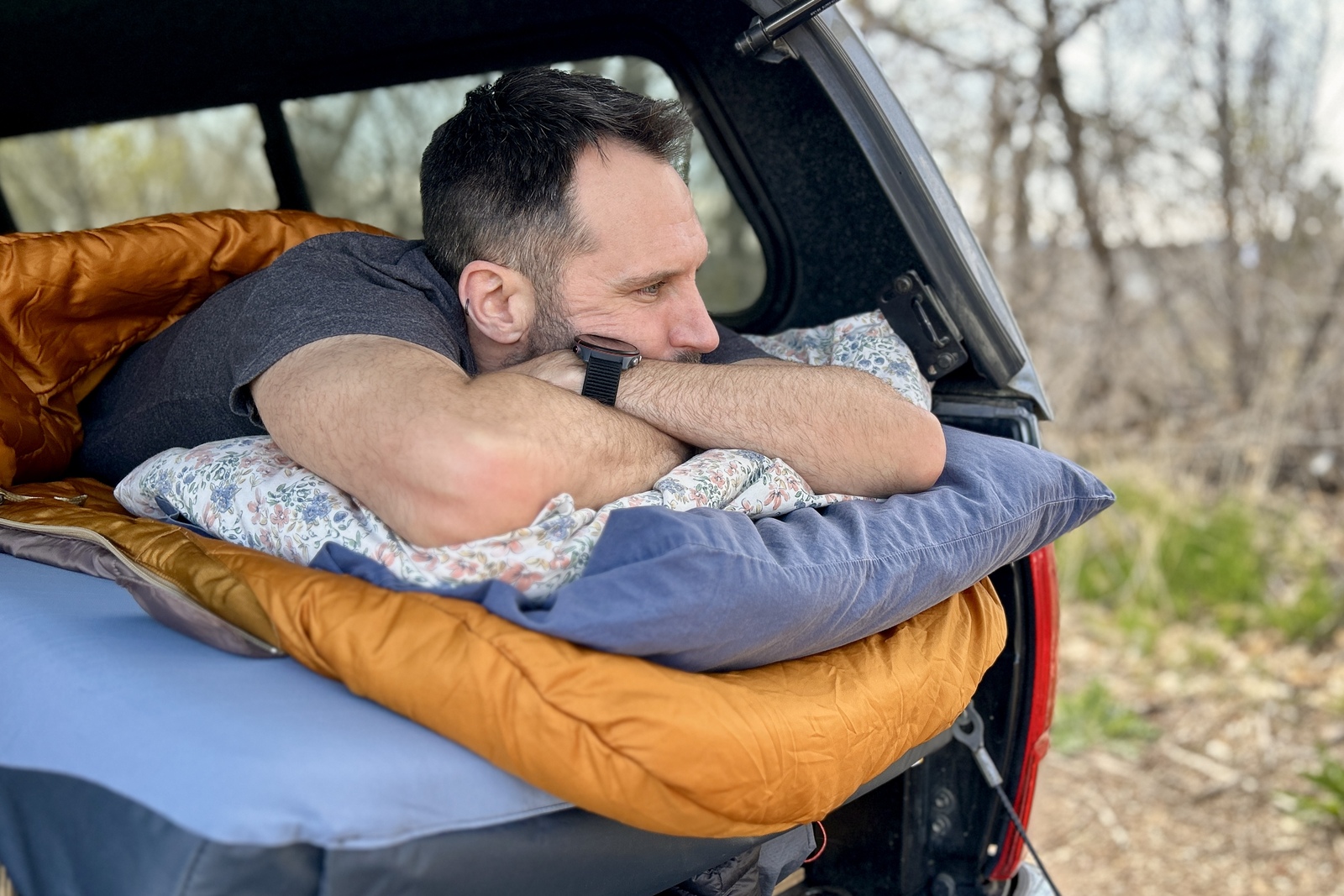
WARMTH
You won’t find a warmer bag than the ALPS OutdoorZ Redwood -10. This model easily withstands extreme cold temperatures down to -10°F thanks to a heavy-duty cotton canvas outer shell and brushed cotton flannel liner that provides exceptional warmth. The bag’s massive size and quilted construction trap heat effectively, while the draft tubes along the zippers and around the shoulders minimize heat loss. The combination of quality materials and stellar construction makes this bag our go-to for the absolute coldest conditions.
The North Face One Bag is another outstanding choice for warmth. The modular design allows three interchangeable layers, so it can adapt to various temperature ranges, making it suitable for sub-zero conditions when fully assembled. The synthetic and down layers provide excellent warmth and versatility and perfectly-placed draft collars and a cinchable hood enhance heat retention. Plus, the ability to configure the layers based on the weather offers a customizable warmth experience.
Another of our top choices, the Teton Sports Celsius Grand XXL 0F, is built for freezing temperatures rated down to 0°F. It features some of the loftiest synthetic insulation on the market, which offers good warmth even in damp conditions. The bag’s mummy shape, oversized hood, and full-length zipper draft tubes retain heat effectively. And, we love the brushed flannel lining to add a cozy feel with double-layer construction for consistent warmth all night.
We highly recommend the Mountain Hardwear Bishop Pass 15. This bag uses high-quality 650-fill-down insulation, which provides an excellent warmth-to-weight ratio. The bag’s mummy shape, contoured foot box, and insulated draft tube help maintain warmth, and the lightweight yet durable construction makes it ideal for sleeping in cold conditions where warmth and weight are priority.
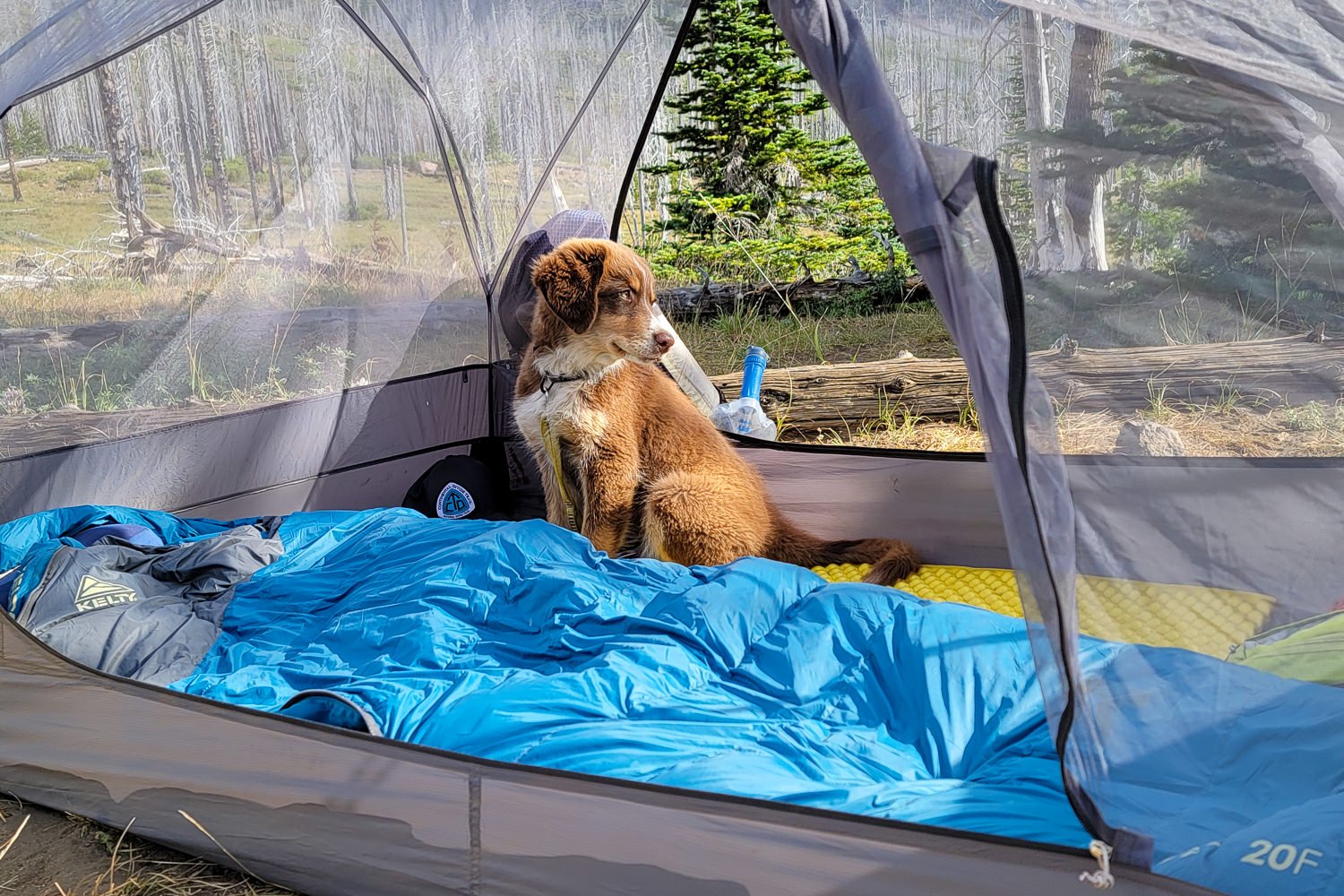
PACKED SIZE
If you’re looking for a bag that packs small, insulation type and fill power matter for compression. That’s why both the Kelty Cosmic Down 20 and Mountain Hardwear Bishop Pass 15 are at the top of the list. They utilize down insulation, which is highly compressible and packs down to a smaller size compared to synthetic fills.
The fill power of their down – 600 fp for Kelty and 650 for Mountain Hardwear – contributes to their ability to shrink down. Lightweight materials in the shell and liner also play a crucial role in overall packed size, and these ones benefit from the use of lightweight nylon, which compresses better and occupies less space than other materials.
Two very close alternatives are the NEMO Disco Endless Promise 30 and the Therm-A-Rest Boost 650. They don’t quite achieve the same compact size, but it’s close, and we’re splitting hairs here. They also utilize lightweight materials and highly-packable designs perfect for backpacking or car camping.
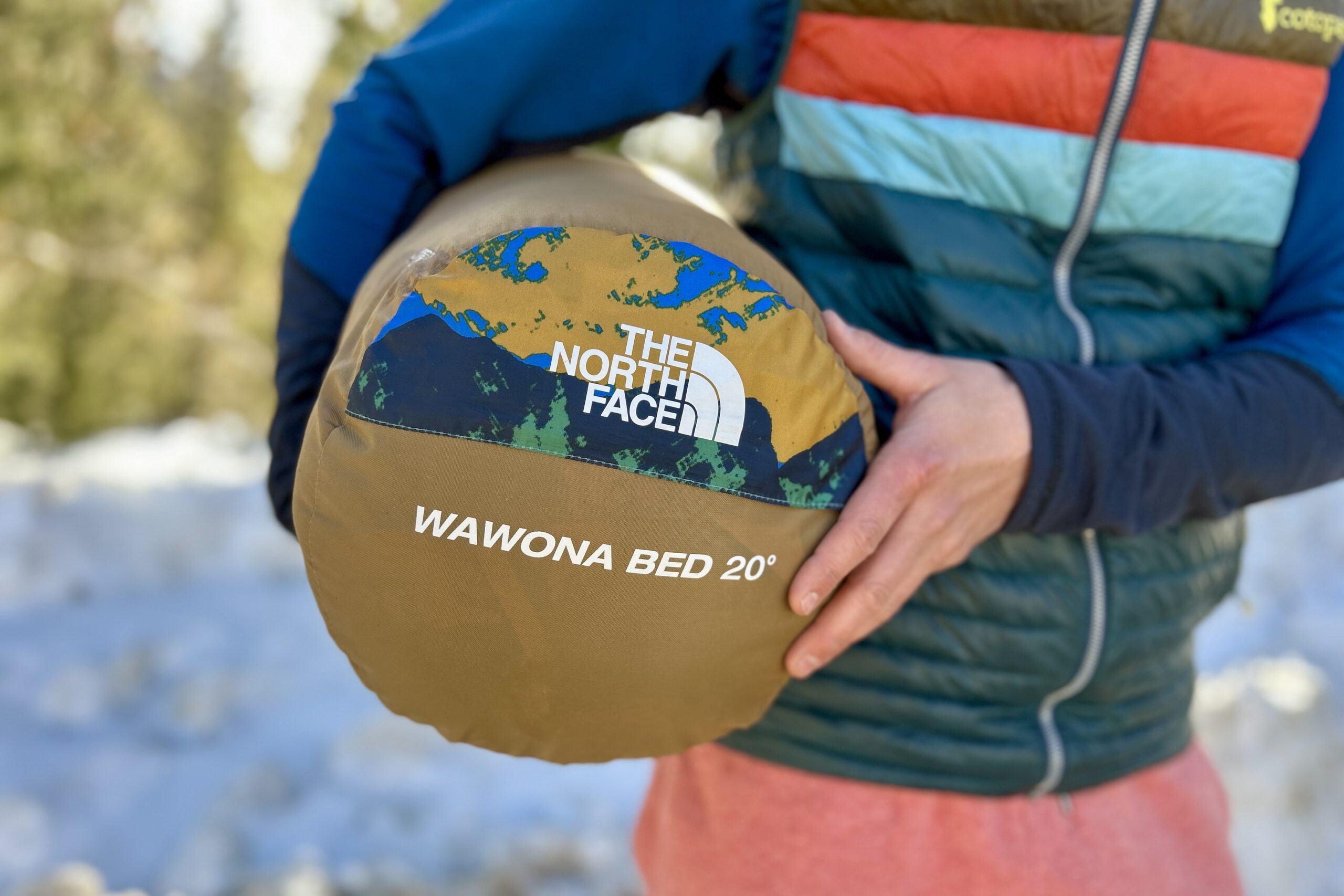
FEATURES
The most feature-rich sleeping bags we tested are The Therm-A-Rest Boost 650, the North Face One Bag, the NEMO Jazz Double 30, and the REI Siesta Hooded 20. All four bags feature oversized hoods as well as large neck baffles and draft tubes that enhance warmth and comfort. They include internal pockets to stash small items like your phone or chapstick for fast access. The mummy-style hood of the Boost 650 and The North Face One Bag provides a snug fit, while the Jazz 30 Double has a hood big enough to hold two full-sized pillows.
The Boost 650 is full of lightweight zippers that offer unique and handy features. Unzip the center of the back to expand the width, transforming it from a mummy bag into a spacious car-camping bag. Unzip two zips on the side to vent heat or completely stick your arms out for unrivaled dexterity while staying warm inside the bag, and completely zip the bag down to the base of the footbox and use it as a quilt.
The North Face One Bag has a zipper that extends all the way around the perimeter to customize temperature regulation and breathability. We also appreciate the glow-in-the-dark zipper pulls that make it easy to adjust the bag when it’s dark.
The NEMO Jazz 30 Double is perfect for two campers with zippers that run down the side for separate in and out, as well as ventilation for each person. An included polyester sheet adds warmth and bed-like comfort. This one also has a mattress sleeve on the underside to prevent slipping and sliding at night.
How to Choose a Camping Sleeping Bag
CHOOSING A TEMPERATURE RATING
How do you choose the “right” temperature rating? Many things contribute to how hot or cold you might feel, like packing the right clothing, staying hydrated before bed, eating plenty of calories at dinner, altitude of your campsite, and especially the insulation of your sleeping pad / mattress.
We’re confident all of the bags on this list will keep the average camper comfortable in typical temperate summer conditions, with overnight temps mostly in the 40s and 50s, with some bags rated for much lower or a little higher. However, if you already know you’re a hot or cold sleeper, take that into account when weighing your options.
- Temperature Rating: Most sleeping bags have a number listed after their name: for example, the NEMO Jazz 30. As mentioned above, this number represents the lower limit of the bag, which is around 10-15°F less than what is comfortable. Look for bags with a standardized EN Comfort Rating. The EN rating gives a more practical, real-world idea of how the bag will feel to the average sleeper. That said, it’s rare to see EN Comfort Ratings on frontcountry camping bags. If you don’t see a comfort rating, just add 10-15° to the temperature rating listed by the manufacturer.
- Increase your Temperature Rating – Remember, you can always add layers to increase the warmth of your bag. If you sleep cold or know there will be a major drop in temperature, simply throw a camp blanket over the top, use a silk bag liner on the inside, or simply wear additional layers to add warmth. We recommend sleeping in base layers and a warm hat on really chilly nights. Also consider eating food right before bed so your body has calories to burn, drinking plenty of water to keep hydrated, or even sliding a hot water bottle inside your sleeping bag a few minutes before you hop in.
WHERE DOES THE DOWN COME FROM?
Down is the soft, fine layer of feathers beneath the outermost plumage on ducks and geese. These tiny feathers help keep the birds warm, especially in very cold weather. Most down comes from birds used for meat, and a large portion of the world’s down – around 70% – is supplied by China.
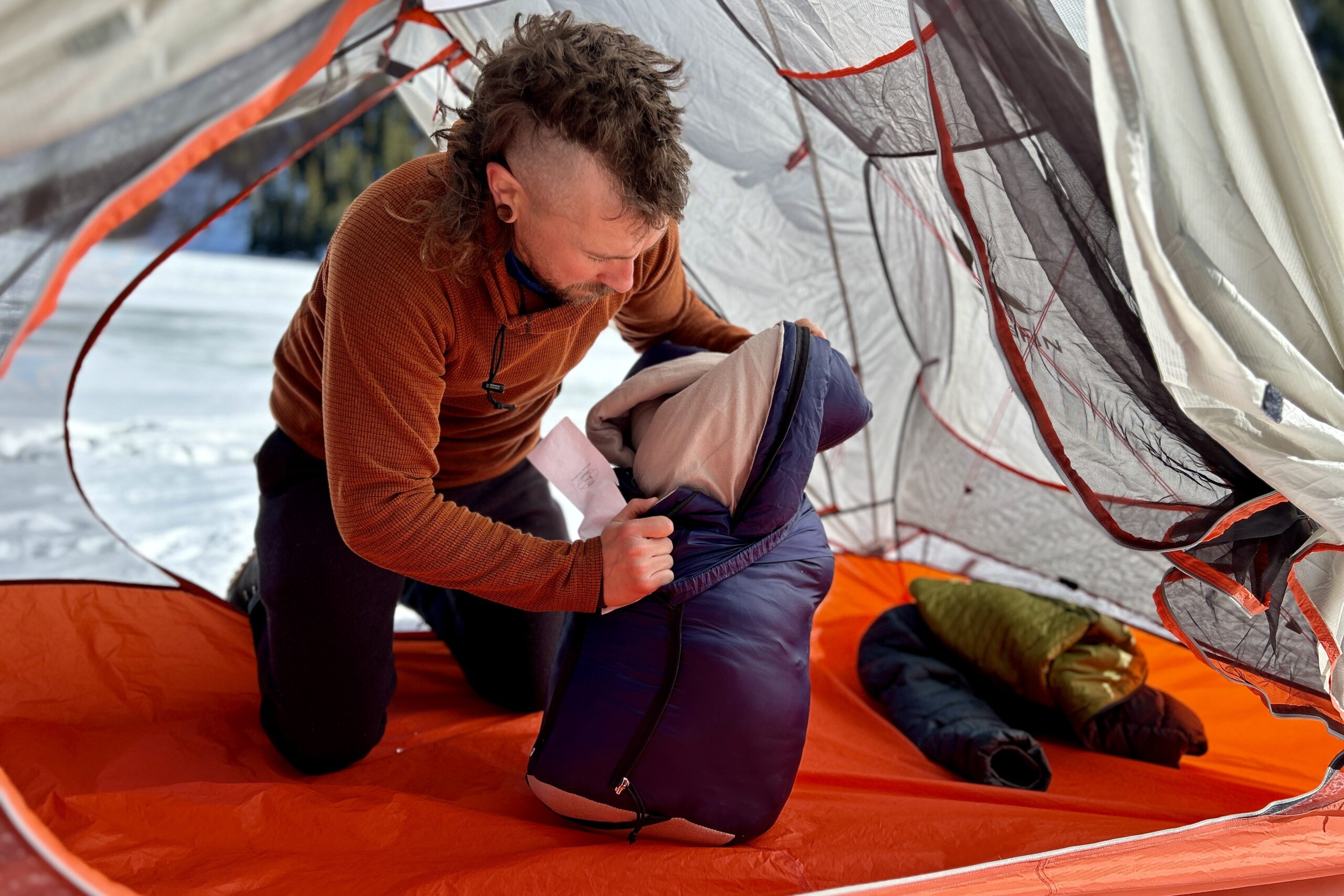
DOWN FILL POWER VS. SYNTHETIC
Fill power (fp) specifically refers to the quality of down insulation in down sleeping bags – note that this rating doesn’t apply to synthetic bags. Higher numbers mean the down is lightweight, compresses better, and usually costs more. Ratings above 800-fill-power are top-notch. If the number is lower, it’ll likely cost less, but won’t be as warm for the weight.
When it comes to synthetic insulation, quality is measured by the type of material used and the steps taken in its construction. Synthetic bags may use terms like “weight” or “thickness” to describe their insulation quality. As a result, measurements are harder to compare and gauge for synthetic sleeping bags.
BAG LENGTH & WIDTH
Sleeping bags generally aim to eliminate areas of dead heat – pockets of interior volume that your body has to expend energy to keep warm. Mummy bags, because of their tapered bottoms and more snug fit, tend to feel the warmest, although they can be narrow and restrictive for sleepers who like to spread out. Unfortunately, mummies rarely come with wide options, so you’ll want to look elsewhere if the bag is too slim.
Rectangular and wider bags may feel a bit colder in chilly temperatures due to cold spots in the corners or at the edges. However, if you’re a belly or side sleeper, or tend to move a lot at night, a wider orientation will feel more natural and comfortable. Plus, many rectangular bags have zippers that extend the entire length of one side for venting. Many have zippers that wrap around to the opposite corner so they can open up into a blanket or quilt, offering maximum versatility for ventilation and comfort.
In general, we recommend choosing the wider version of most sleeping bags, regardless of your sleeping position. In our experience, the more room you have to roll over and adjust, the more comfortable you’ll be.
DWR
DWR, or Durable Water Repellent, is a treatment for the outside fabric of your sleeping bag – down and synthetic – that adds a layer of water resistance. When this treatment is done regularly, instead of soaking into the fabric, water will bead up and stay on the outer shell. By no means does this make your bag fully waterproof, but it adds an important bit of extra protection. Many sleeping bags already come with a DWR coating, but just like rain jackets and rain pants, it eventually wears off and you’ll need to reapply it. To learn how, check out our guide How To Clean & Wash Your Sleeping Bag, including steps on reapplying DWR.
WASHING & STORAGE
When it comes to durability, down is excellent, but it loses efficiency over time as it gets oily, dirty, and compressed. Synthetic materials may last a bit longer, but it’s lifespan also depends on proper storage and maintenance so it can last year after year of regular use. For details on how to care for your bed-away-from-bed, head over to our article How to Repair, Wash, Store, & Care For Your Sleeping Bag.
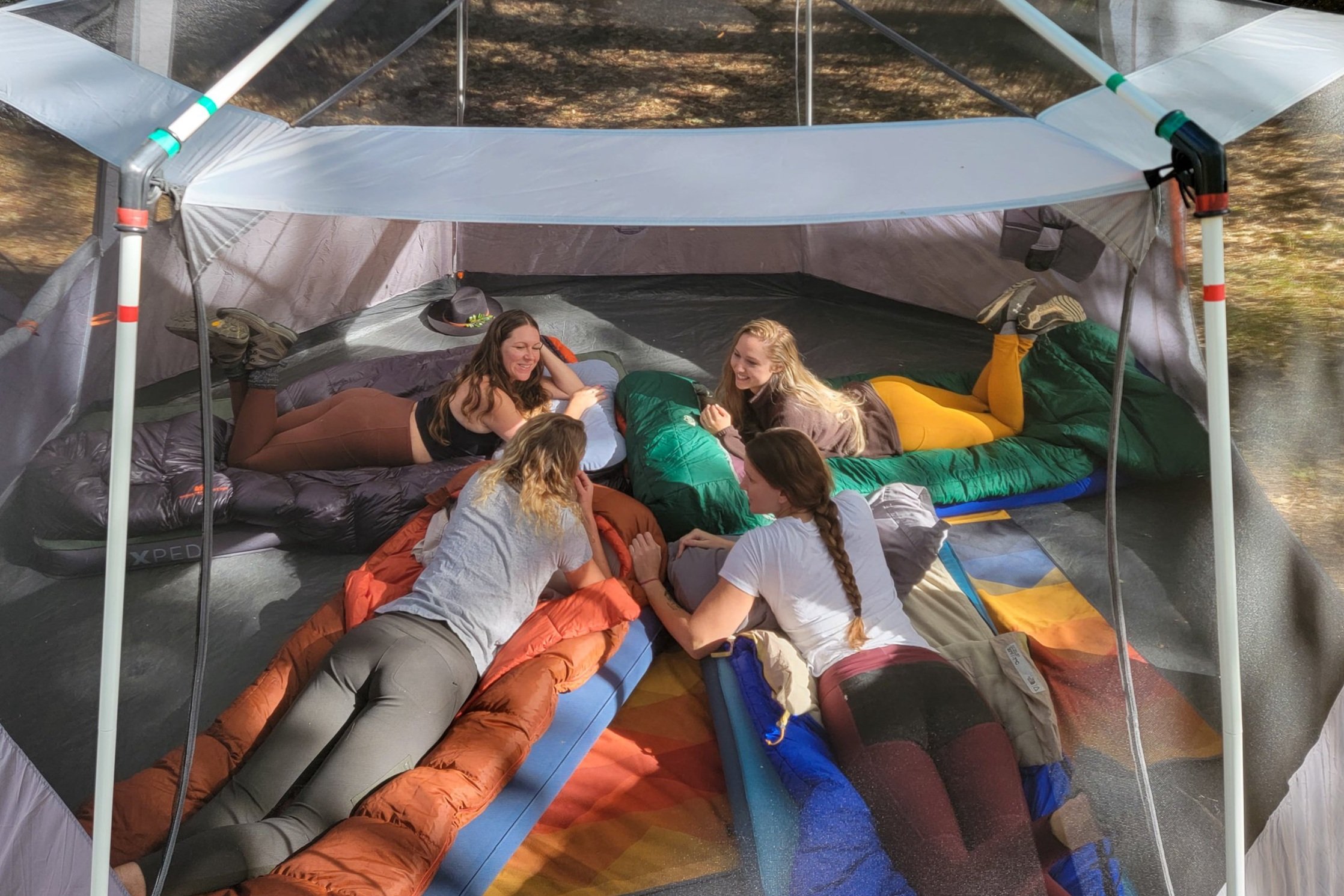
Conclusion
Choosing the right sleeping bag can make or break your camping experience, so we hope this guide has provided valuable insights to help you find the ideal frontcountry bed for your next camping trip. Remember to consider comfort, warmth, packed size, and features to help determine the best value and the perfect fit for you.


